
Project Gutenberg's Lincoln in Caricature, by Rufus Rockwell Wilson This eBook is for the use of anyone anywhere at no cost and with almost no restrictions whatsoever. You may copy it, give it away or re-use it under the terms of the Project Gutenberg License included with this eBook or online at www.gutenberg.org Title: Lincoln in Caricature Author: Rufus Rockwell Wilson Release Date: March 7, 2014 [EBook #45069] Language: English Character set encoding: ISO-8859-1 *** START OF THIS PROJECT GUTENBERG EBOOK LINCOLN IN CARICATURE *** Produced by David Widger from page images generously provided by The Internet Archive

INCOLN in caricature is a phase of the career of the great war President that has thus far lacked adequate treatment. Yet he was the most bitterly assailed and savagely cartooned public man of his time, and one has only to search the newspapers and periodicals of that period to find striking confirmation of this fact. The attitude of Great Britain toward the Union and its President was then one of cynical and scarcely veiled hostility, and nowhere were the sentiments of the English government and of the English masses more faithfully reflected than in the cartoons which appeared in London Punch between 1861 and 1865, many of which had Lincoln for their central figure. He was also frequently cartooned in Vanity Fair the American counterpart of Punch; in Frank Leslie's Illustrated Newspaper, and in Harper's Weekly. Indeed, nowhere were the changing sentiments of the people of the North, their likes and dislikes, their alternates hopes and fears, their hasty, often unjust judgments of men and measures, more vividly reflected than in the cartoons dealing with Lincoln which appeared in the last named journal during the epoch-making days of his Presidency. Thus the thirty-two plates from these sources here brought together have a value and interest already important and sure to increase with the passage of time, for they reflect with unconscious vividness, and as nothing else can do, the life and color of an historic era, and how his fellows regarded the grandest figure of that era. It is with their value as human documents in mind that they have been rescued from their half-forgotten hiding places, and assembled in chronological sequence, with such comment as may be necessary to make their purpose and meaning clear to older men, whose memory may have grown dim, as well as to the new generation that has come upon the stage in the eight and thirty years that have elapsed since the close of the Civil War.
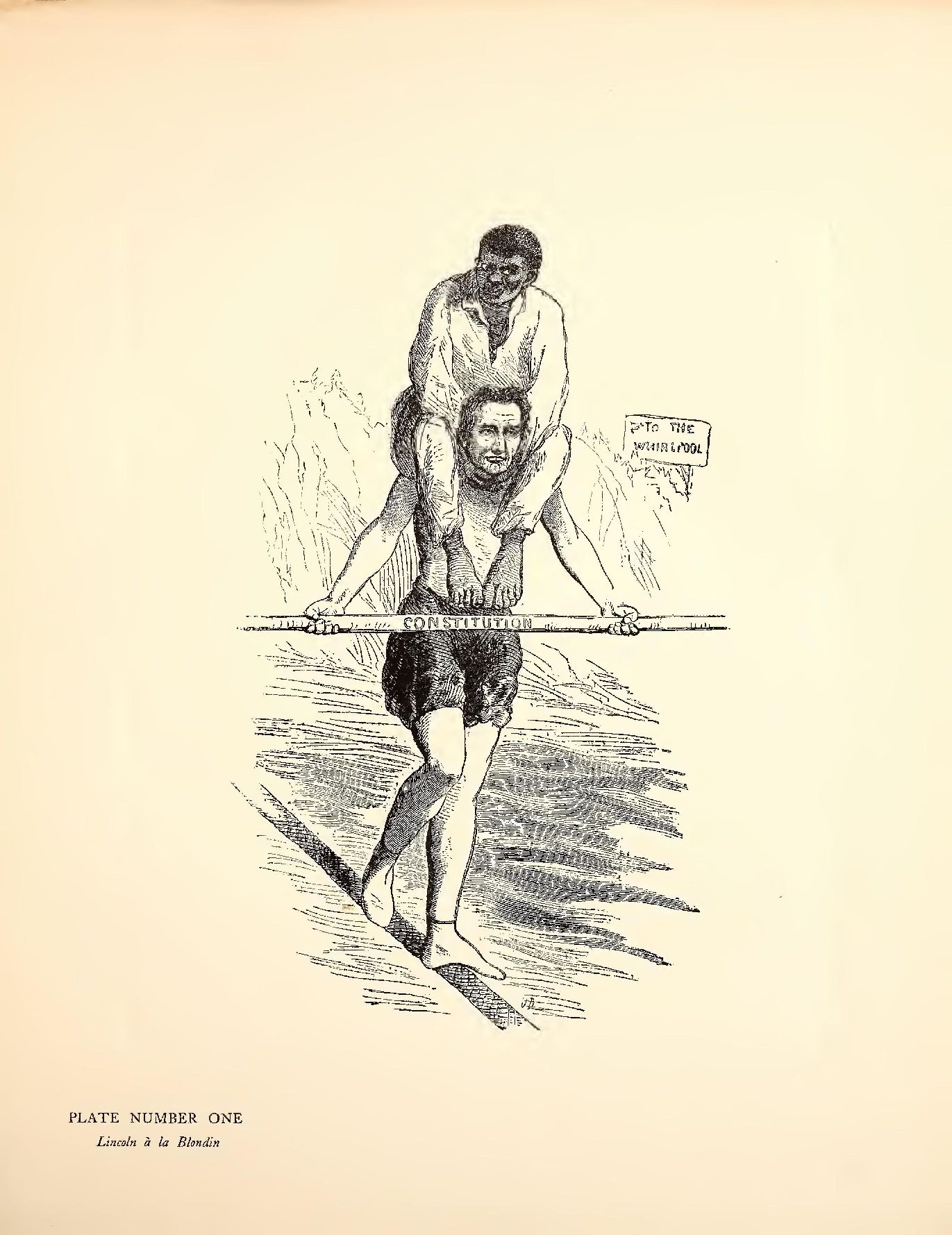
Plate Number One—This cartoon, "Lincoln à la Blondin," which appeared in Harper's Weekly, on August 25, 1860, seems to have been suggested by Blondin's crossing of Niagara on a tight rope with a man on his back—an event then fresh in the public mind. It also recalls an interesting phase of Lincoln's first campaign for the Presidency, which had its origin in a characteristic incident of the candidate's earlier years. It was in March, 1830, that Lincoln, at that time a youth of twenty-one, removed with his father and family from Indiana to Illinois, locating on the bluffs of the Sangamon River about ten miles from Decatur. There he and his kinsman, John Hanks, built a hewed log house, and broke fifteen acres of prairie sod with the two yoke of oxen they had driven from Indiana. They then felled the trees, cut off the logs, and with mauls and wedges split the rails to fence in the land they had broken. The following winter, the winter of the "deep snow" as it was known in Illinois, Lincoln alone made three thousand rails for a neighbor, walking three miles each day to do it. The Republican state convention of Illinois assembled at Decatur on May 9, 1860, and the first act of its chairman was to invite Lincoln, who was modestly seated in the body of the hall, to a seat upon the platform. An eye-witness describes the scene that followed as one of tumultuous enthusiasm. No way could be made through the shouting throng, and Lincoln was borne bodily, over their heads and shoulders, to the place of honor. Quiet restored, the chairman again arose and said:
"There is an old Democrat outside who has something he wishes to present to this convention."
Then the door of the hall swung open, and a sturdy old man marched in, shouldering two fence-rails, surmounted by a banner inscribed, in large letters:
"Two rails from a lot made by Abraham Lincoln and John Hanks in the Sangamon Bottom, in the year 1830."
The bearer was John Hanks himself, and he had come to do his part in making his old friend President. "It was an historic scene and moment. In an instant Lincoln, the rail-splitter, was accepted as the representative of the working man and the type and embodiment of the American idea of human freedom and possible human elevation. The applause was deafening. But it was something more than mere applause," for there was no opposition afterwards, to a resolution that declared Lincoln to be the first choice of the Republicans of Illinois for President, and instructed the delegates to the national convention to cast the vote of the State as a unit for him. It is a part of history how the tidal wave of enthusiasm behind this resolution swept from Decatur to Chicago, and thence over the country.
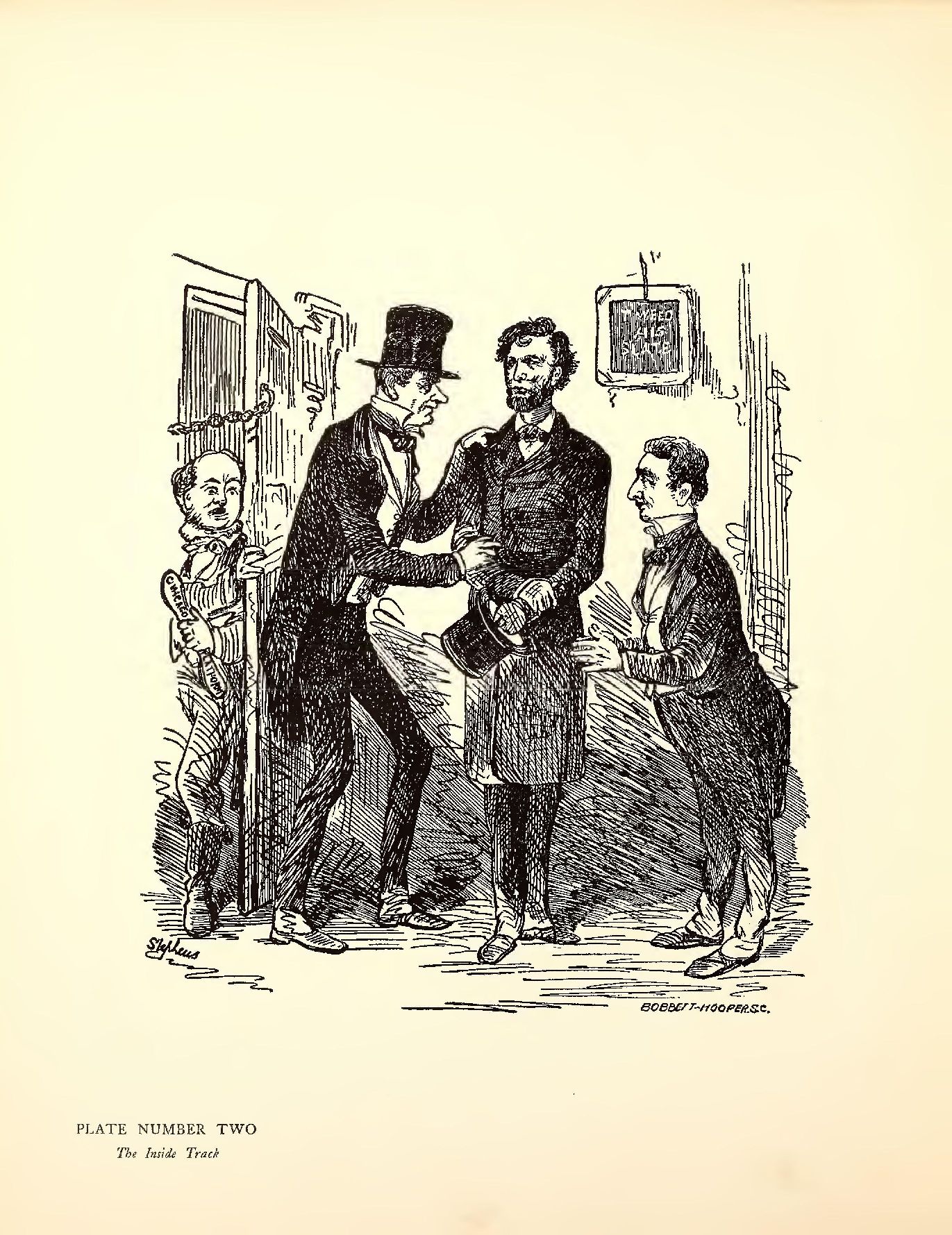
Plate Number Two—This cartoon, "The Inside Track," published in Vanity Fair, on March 2, 1861, has for its motive the popular doubt and incertitude attending the make-up of the Cabinet and the policy of the new Administration toward the South. The President-elect is shown, with a doubtful expression on his face, flanked on either side by Thurlow Weed, who is drawn to represent a western river gambler of the period, and William H. Seward, while Horace Greeley, their sworn political foe, thrusts his head through the door in time to hear Weed remark impressively: "Trust to my friend Seward—trust to us. We'll compromise this little difficulty for you. But trust to us. Gentlemen from the country are often swindled by unprincipled sharpers. Trust to us." Seward, as we know, became Lincoln's Secretary of State, and Weed one of his trusted advisers, while the editor of the Tribune remained until the end a thorn in the side of the President.
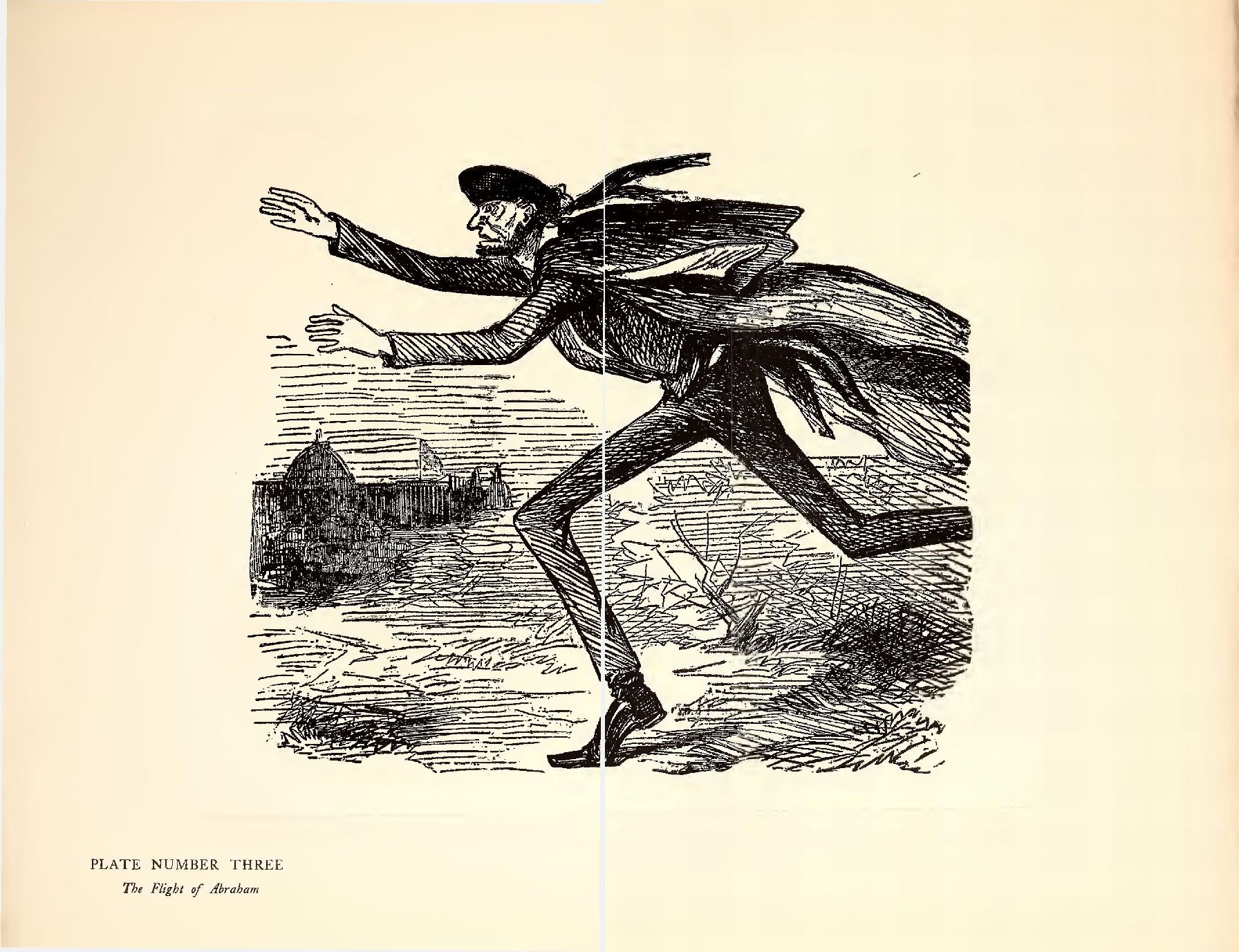
Plate Number Three—This cartoon, "The Flight of Abraham," published in Harper's Weekly, on March 9, 1861, holds up to ridicule Lincoln's memorable secret journey from Harrisburg to Washington, but its point-of-view is a mistaken one. Lincoln's advisers had good grounds for believing that there existed a plot to murder him during his passage through Baltimore, and every consideration forbade needless risk. The trip across Maryland was, therefore, made suddenly and in private, but there was no attempt at personal disguise, as the cartoon infers, nor any undignified concealment on the part of Lincoln or the friends who accompanied him.
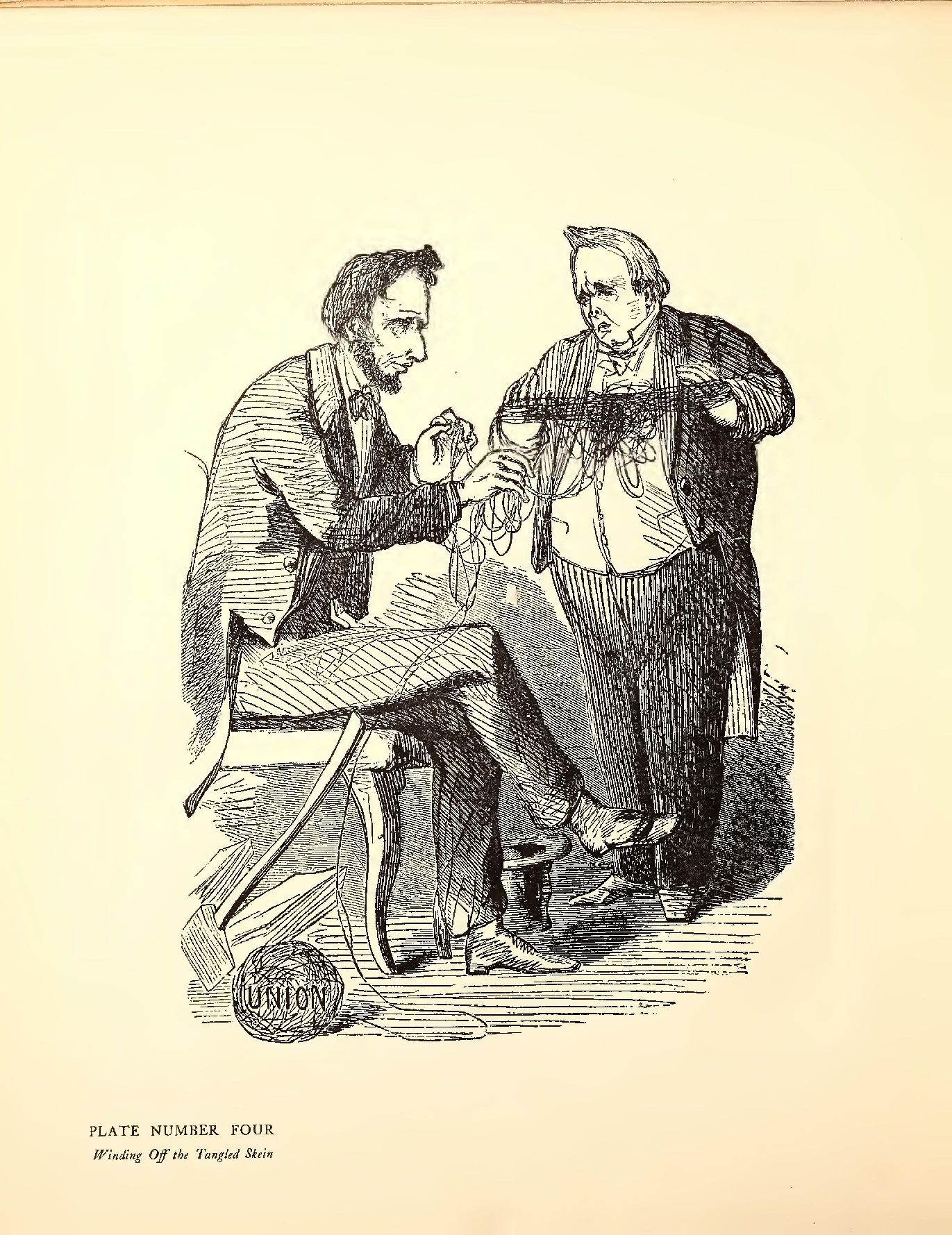
Plate Number Four—This cartoon "Winding Off the Tangled Skein," published in Harper's Weekly, on March 30, 1861, recalls the days of doubt and waiting which preceded the firing on Sumter and the first call for troops.
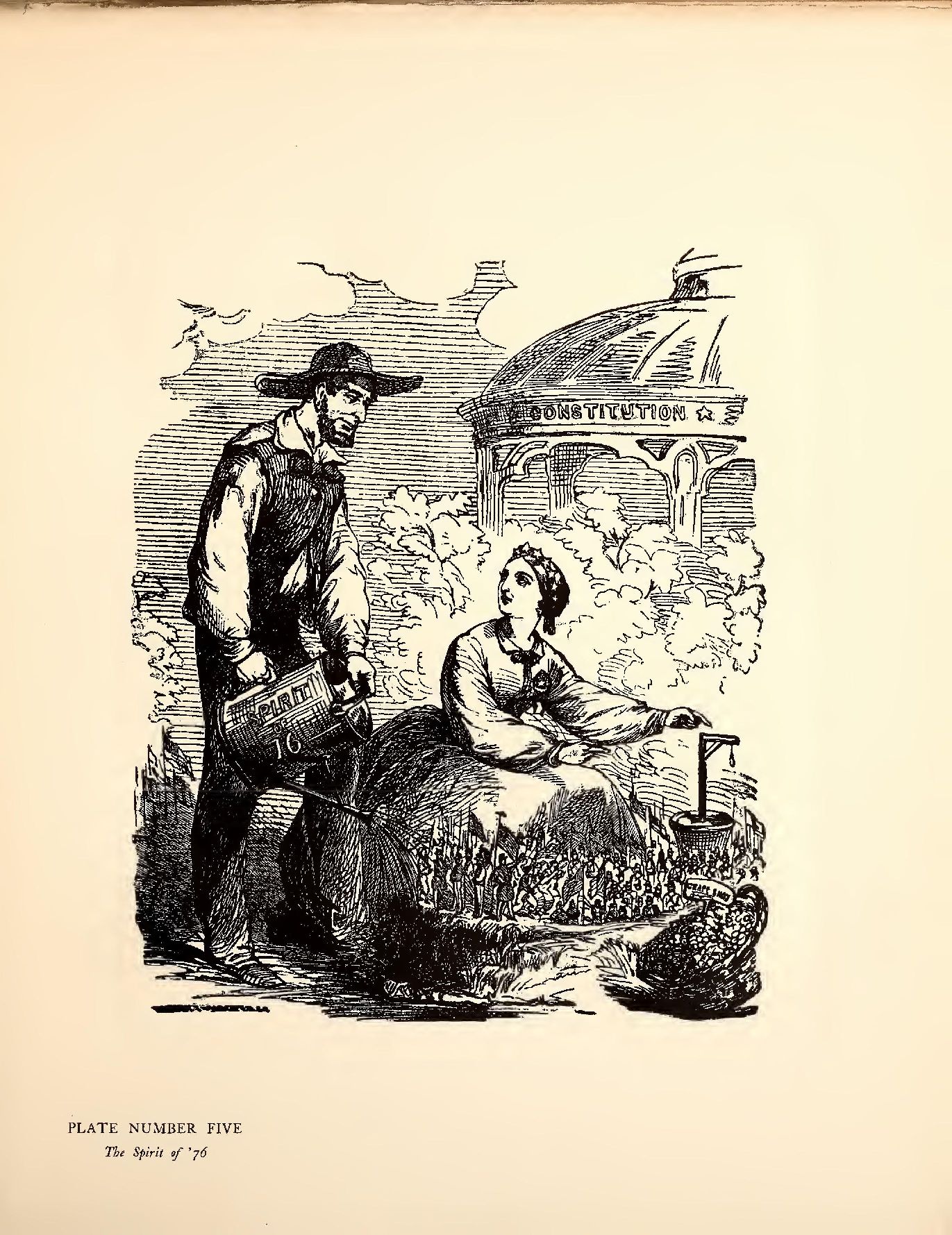
Plate Number Five—This cartoon, "The Spirit of '76," published in Vanity Fair, on May 4, 1861, breathes the spirit which prompted the great uprising of the North when the truth was brought home to its people that a war between the sections was not to be avoided. It shows the President watering a flower bed with the "Spirit of '76," and remarking to Columbia, who watches his work: "Ain't there a nice crop! There's the hardy Bunker Hill flower, the Seventh Regiment pink, the firebug tulip. That tri-colored flower grows near Independence Hall. The western blossoms and prairie flowers will soon begin to shoot."
"What charming plant is this?" asks Columbia, pointing to a miniature gallows.
"That is rare in this country," answers the President. "It will blossom soon and bear the Jeffersonia Davisiana."
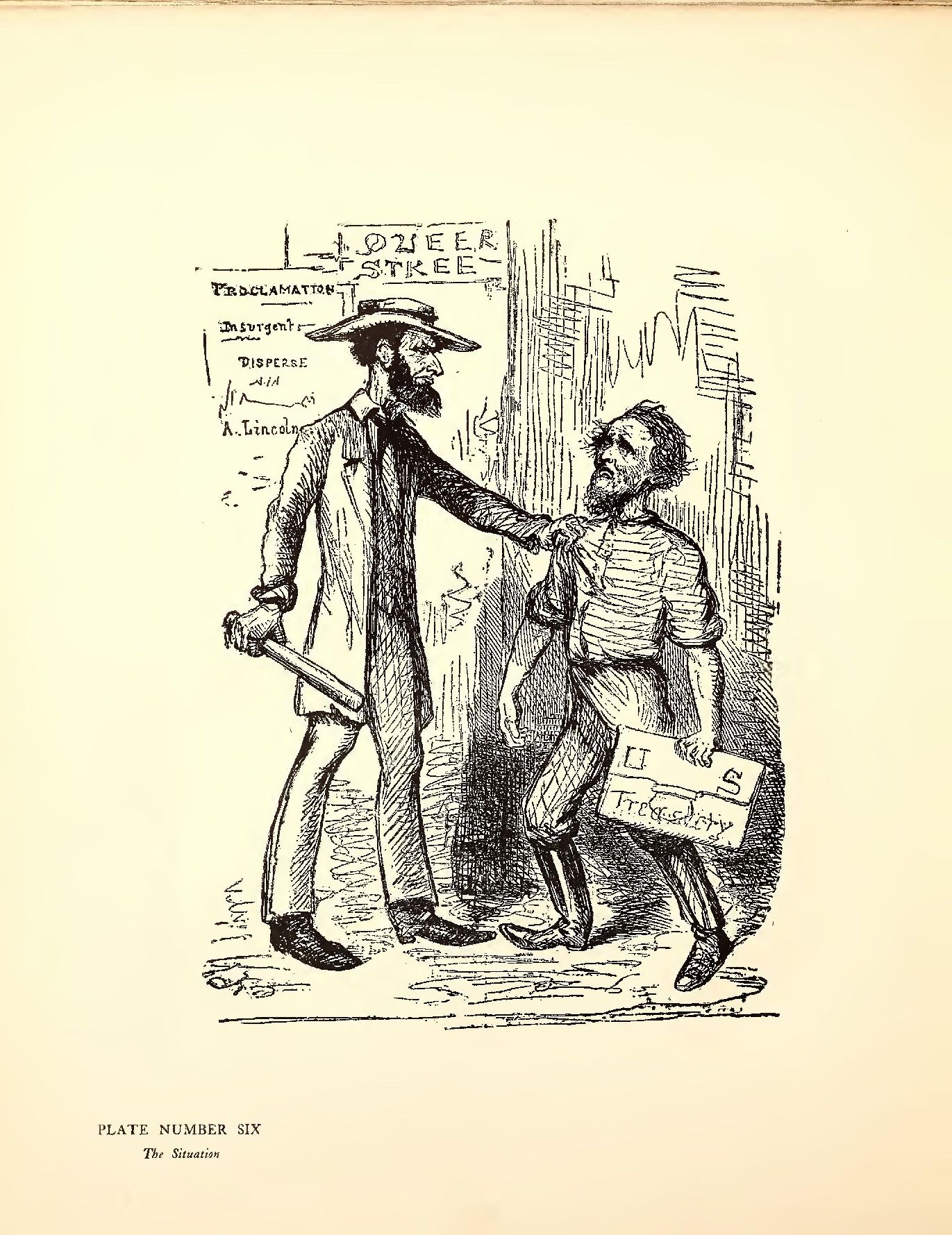
Plate Number Six—This cartoon, "The Situation," published in Harper's Weekly, on July 13, 1861, reminds one that the advocates of compromise were numerous and noisy until well toward the close of the war. Here Lincoln is depicted as a constable in the act of arresting Davis. "I've got you now, Jeff," are his words as he lays hold of his prisoner. "Guess you have," is the reply of Davis. "Well, now let us compromise."
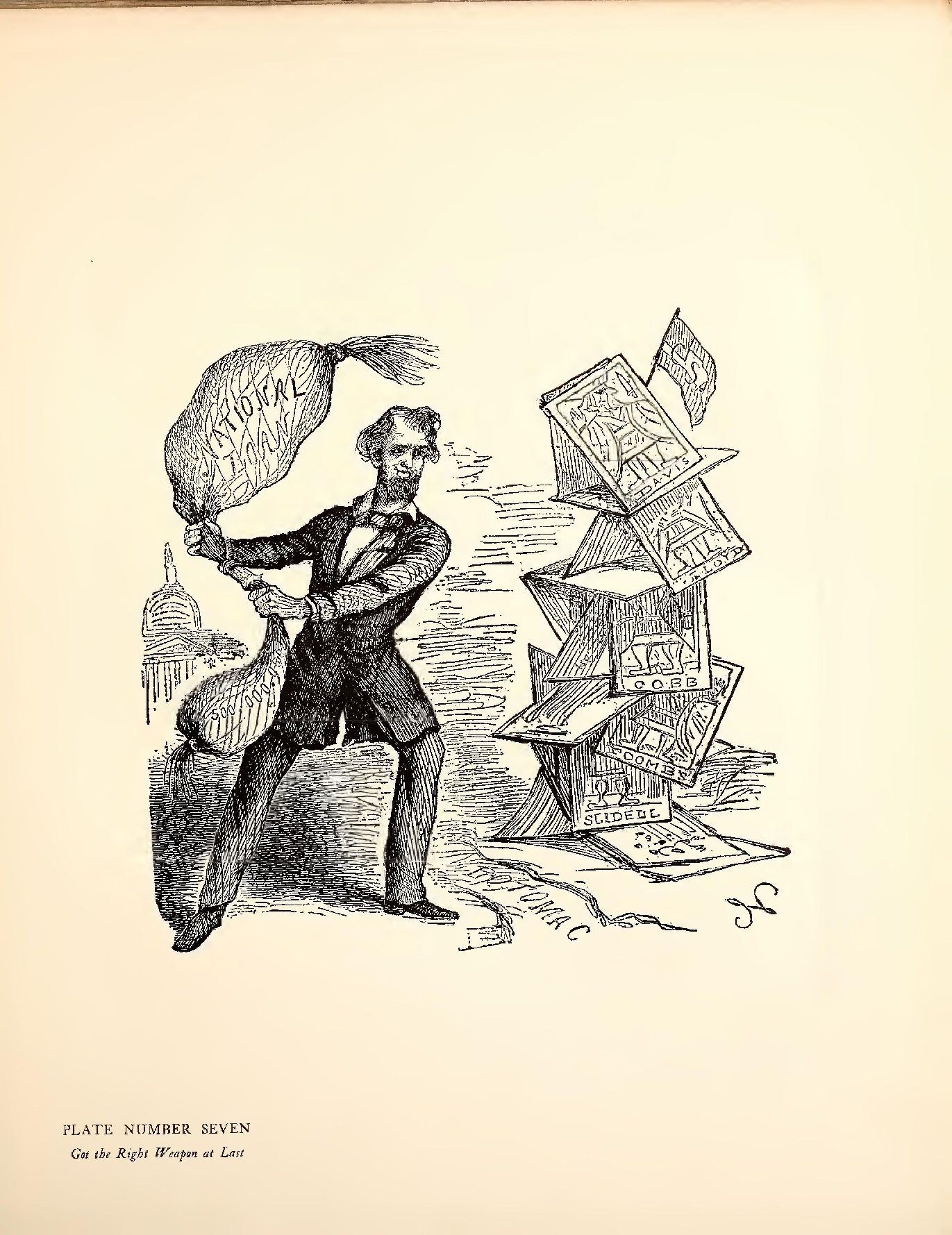
Plate Number Seven—This cartoon, "Got the Right Weapon at Last," published in Harper's Weekly, on October 19, 1861, has for its subject the first of the national loans which assured a successful prosecution of the greatest war in history. Jay Cooke, who still lives, was the agent through whose patriotic and sagacious efforts most of these loans found takers, and he it was to whom Grant, in the closing days of the war, sent this message: "Tell him for me that it is to him more than to any other man that our people will be indebted for the continued life of the nation."
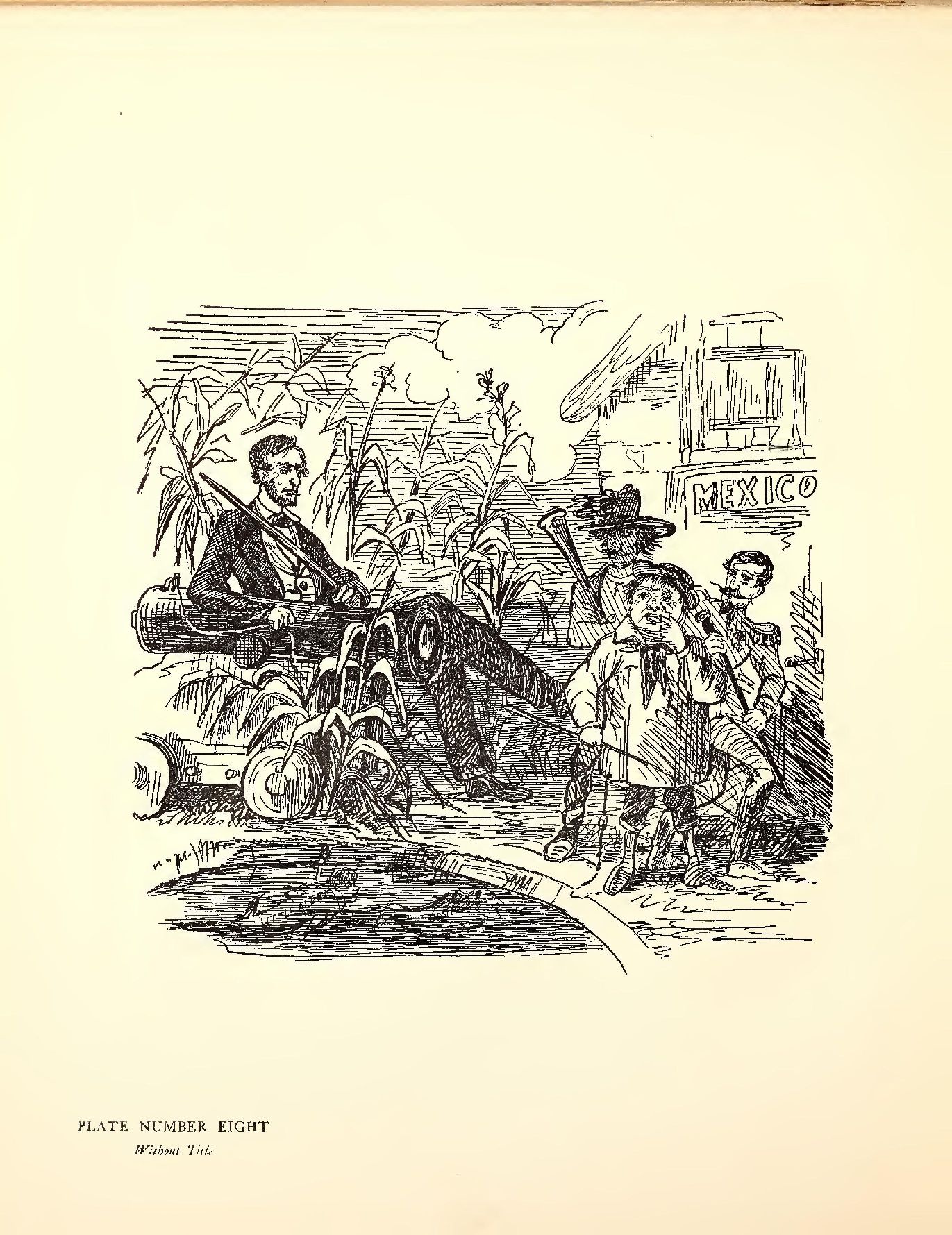
Plate Number Eight—This cartoon, without title, published in Vanity Fair, on November 16, 1861, has for its subject the Union's relations with foreign powers. It depicts the President, guarding with sword and cannon a pond filled with trout (the Confederacy) in which three boys—England, France and Spain—are anxious to cast their lines. "Boys, I reckon I wouldn't," is his significant comment.
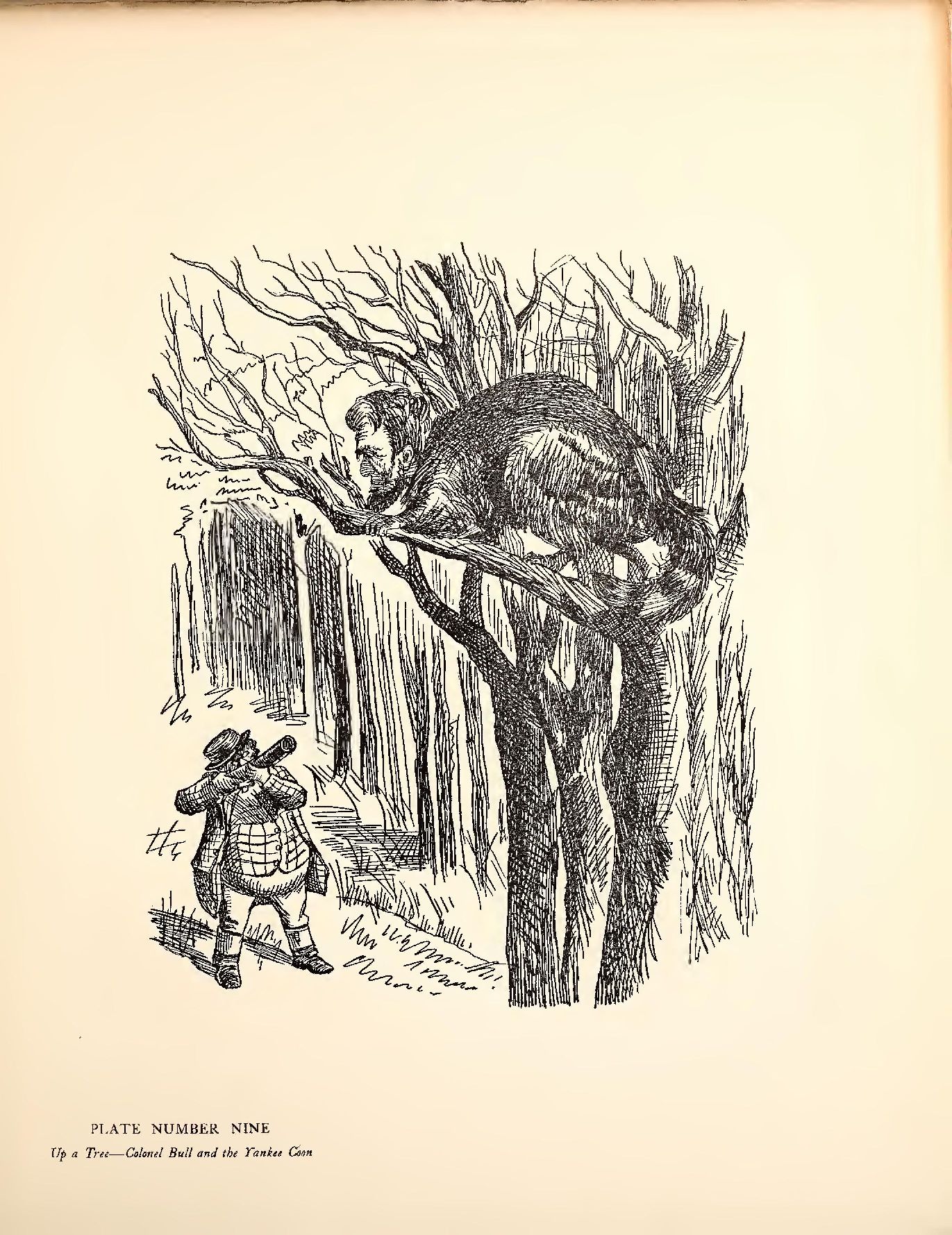
Plate Number Nine—This cartoon, "Up a Tree—Colonel Bull and the Yankee Coon," was published in Punch on January 11, 1862. The artist, whose point-of-view is one of contemptuous ridicule, inspired by the Mason and Slidell incident, and having in mind Davy Crockett's familiar story of Colonel Scott and the coon, depicts that animal with the head of Lincoln, crouched on the limb of a friendly tree, and gazing furtively down on John Bull, armed with a blunderbuss and about to fire, whereat the following dialogue ensues:
Coon—"Air you in arnest, Colonel?"
Colonel Bull—"I am."
Coon—"Don't fire—I'll come down."

Plate Number Ten—This cartoon, "Sinbad Lincoln and the Old Man of the Sea," published in Frank Leslie's Illustrated Newspaper, on May 3, 1862, shows the President as Sinbad carrying on his shoulders the Old Man of the Sea—Gideon Welles, whose course as Secretary of the Navy was then the cause of much ill-natured comment. We had no navy when the war began, and Welles had to create one. His way of doing it provoked much opposition, but he had always the confidence of the President, and so good a judge as the late Charles A. Dana has told us that though "there was no noise in the street when he went along, he was a wise, strong man, who understood his duty, and who was patient, laborious and intelligent at his task." The generous growth of hair which the artist has given Welles was not his own. Instead he wore a wig, which was parted in the middle, the hair falling down on each side, and it was, perhaps, from his peculiar appearance that the idea originated that he was old-fashioned in his methods.
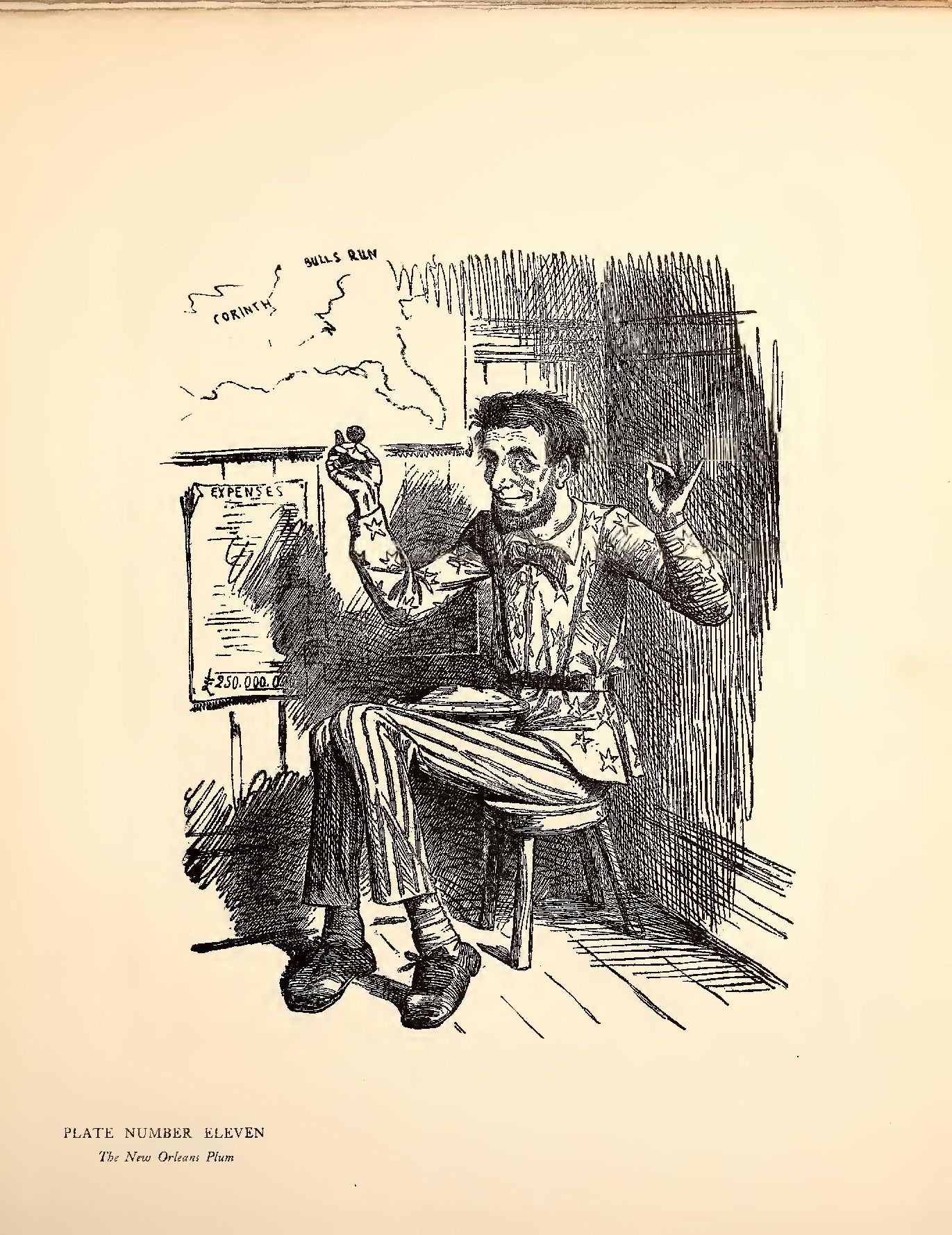
Plate Number Eleven—This cartoon, "The New Orleans Plum," published in Punch on May 24, 1862, deals with the capture of that city, and with it the mouth of the Mississippi—one of the first decisive victories of the war. The artist, borrowing from the old nursery tale, showed Lincoln seated in a corner and plucking a plum from the generous pudding in his lap. Possibly for fear that his design might not be perfectly clear to the British mind, the artist appended to it the legend: "Big Lincoln Horner, up in a corner, thinking of humble pie, found under his thumb, a New Orleans plum, and said,'What a cute Yankee am I!'"
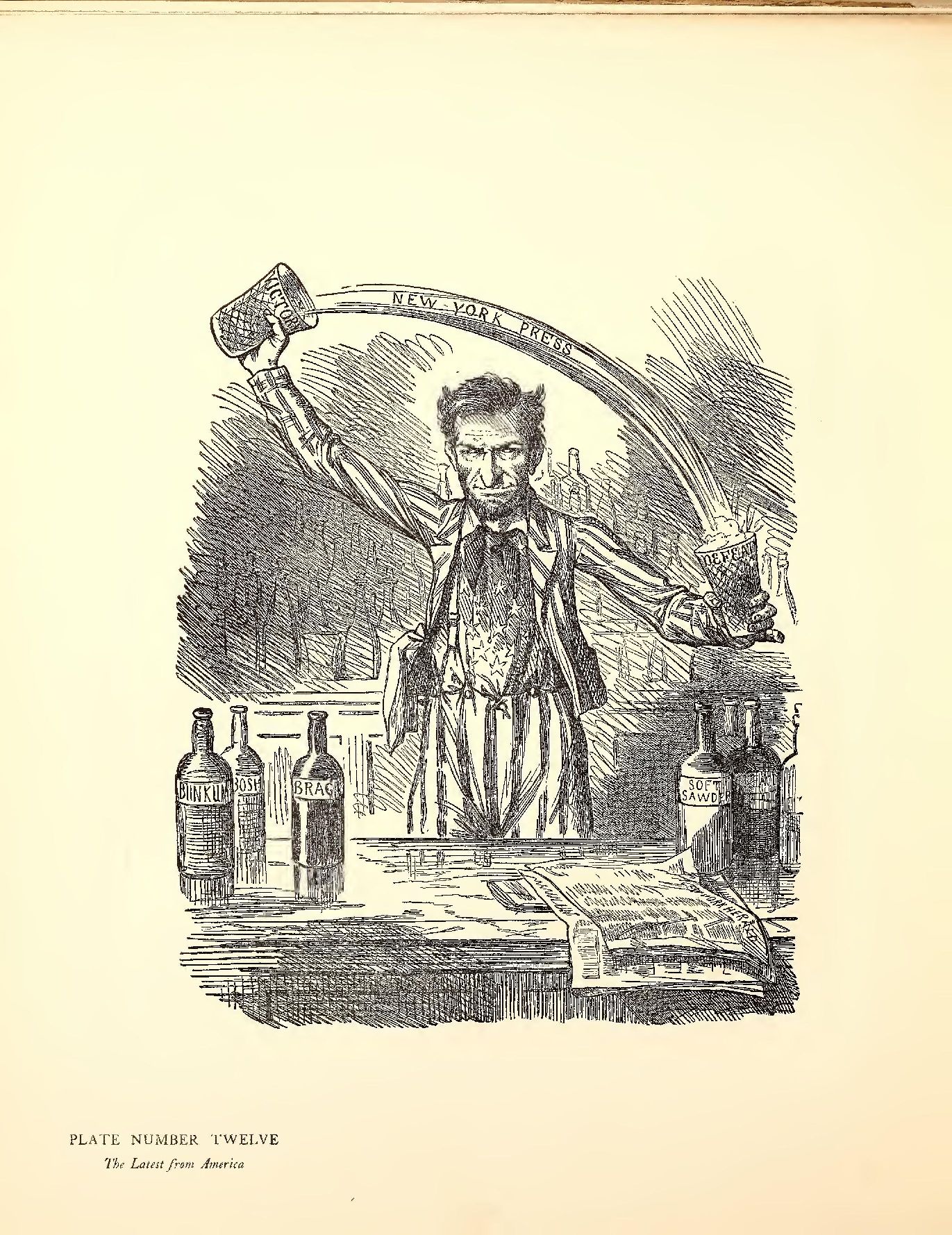
Plate Number Twelve—This cartoon, "The Latest from America," published in Punch on July 26, 1862, aims to make light of the war news sent out from New York at that time. The President is represented as a bartender, standing behind a bar on which are bottles inscribed "Bunkum," "Bosh" and "Brag," and shifting a concoction labelled "The New York Press" from the glass of Victory to that of Defeat.
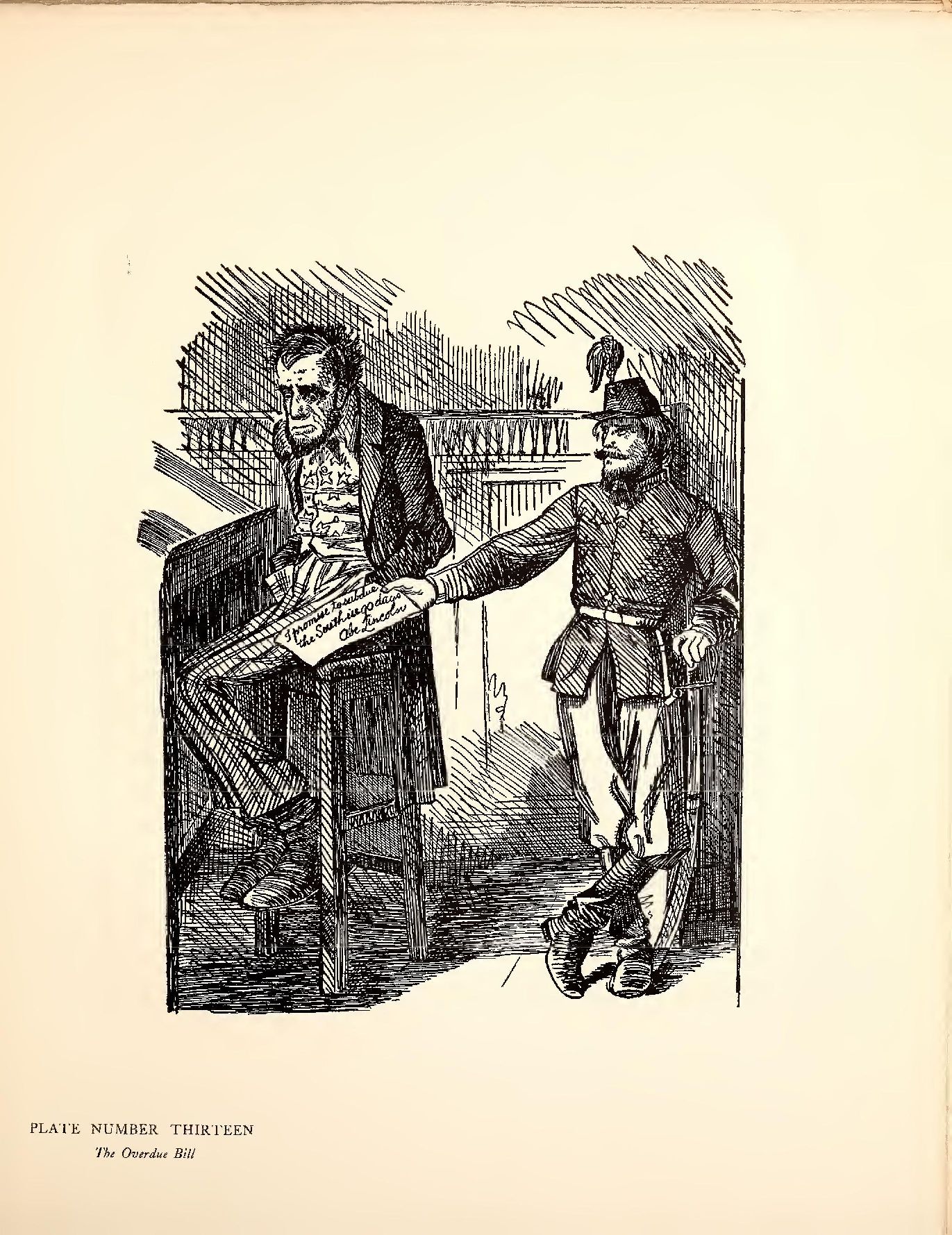
Plate Number Thirteen—This cartoon, "The Overdue Bill," published in Punch, on September 27, 1862, has for its motive the Union's crying need of men and money. The President is shown seated at a desk, with hands, as usual, thrust into his pockets, glancing discomfitedly at a paper inscribed "I promise to subdue the South in ninety days—A. Lincoln," held out to him by a Confederate soldier, who says "Your ninety days' promissory note isn't taken up yet, sirree!" It would have been more fitting to have made Seward the central figure in this cartoon, for it was Lincoln's Secretary of State, and not the President himself, who was loudest in proclaiming that the war would end in three months. It is worth recording that Seward when questioned in after years by a friend as to the reasons which prompted this famous prediction of his, at first declined to give an answer, but finally said that he believed at the time that if the South did not give in within ninety days the North would.
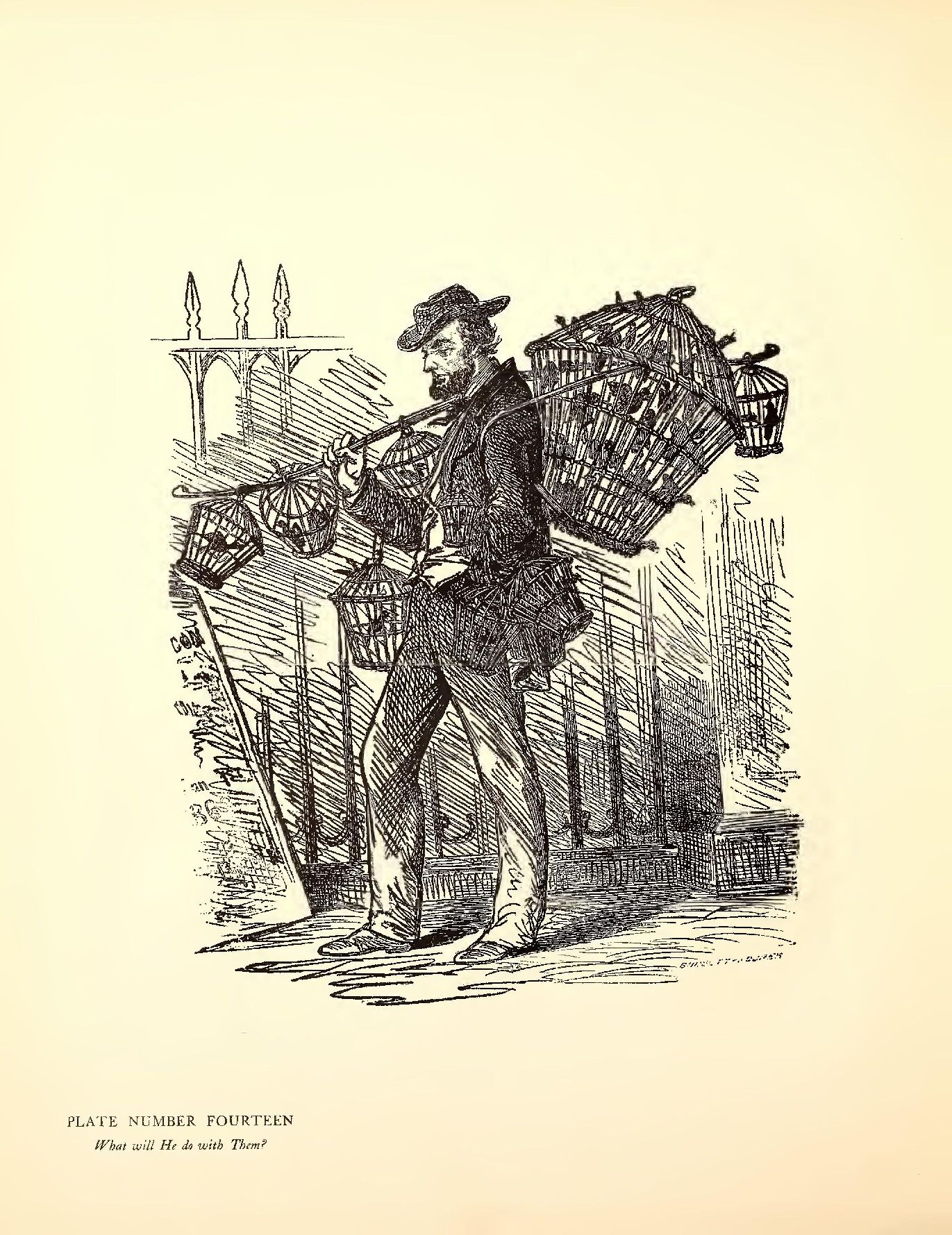
Plate Number Fourteen—This cartoon, "What will He do with Them?" published in Vanity Fair, on October 4, 1862, heralds the forthcoming Emancipation Proclamation, the President being pictured as a vagrom bird-peddler, whom an absence of customers impels to the remark: "Darn these here black-birds. If nobody won't buy'em I'll have to open the cages and let'em fly." This design recalls an historic Cabinet meeting held on the Saturday following the battle of Antietam, which cut short Lee's invasion of the North and compelled him to recross the Potomac. The members of the Cabinet were summoned, on this occasion, not to give advice but to hear a decision. The President told them that the hour for delay had passed, and that the time had come to make the emancipation of the slaves the declared policy of the Administration. Public sentiment would now sustain it. A strong and outspoken popular voice demanded it, and the demand came from the best friends of the government. "And I have promised my God that I would do it," added the President, reverently and in a low voice. "Did I understand you correctly, Mr. President?" asked Secretary Chase, who had heard but indistinctly the low-voiced utterance. "I made a solemn vow, before God," was the answer, "that if General Lee should be driven back from Pennsylvania, I would crown the result by the declaration of freedom to the slaves." And he did.
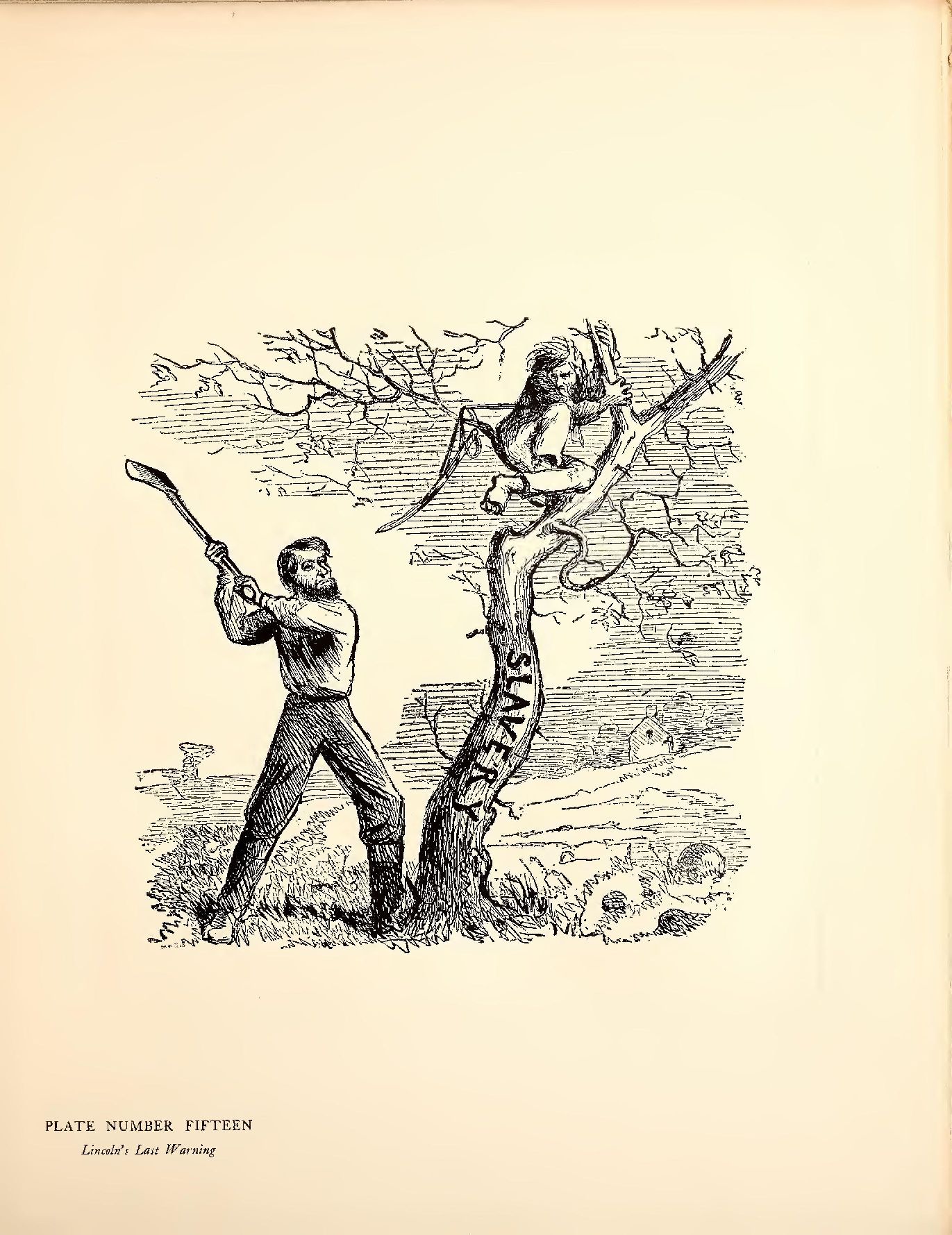
Plate Number Fifteen—This cartoon, "Lincoln's Last Warning," published in Harper's Weekly, on October 11, 1862, also deals with the subject of emancipation. The President is depicted about to apply the axe to the tree of slavery, and saying to Davis, who is crouching in its branches: "If you don't come down, I'll cut the tree from under you."

Plate Number Sixteen—This cartoon, "Keep on the Track," published in Vanity Fair, on November 22, 1862, has to do with the result of the congressional elections of that year. Here the President is made to do duty as a locomotive engineer and to remark to his fireman (Secretary Seward), who is staggering under a load of fagots, each inscribed "Democratic Majority:" "I've got the right fuel now and I guess I can keep her steady. Chuck in more, William."
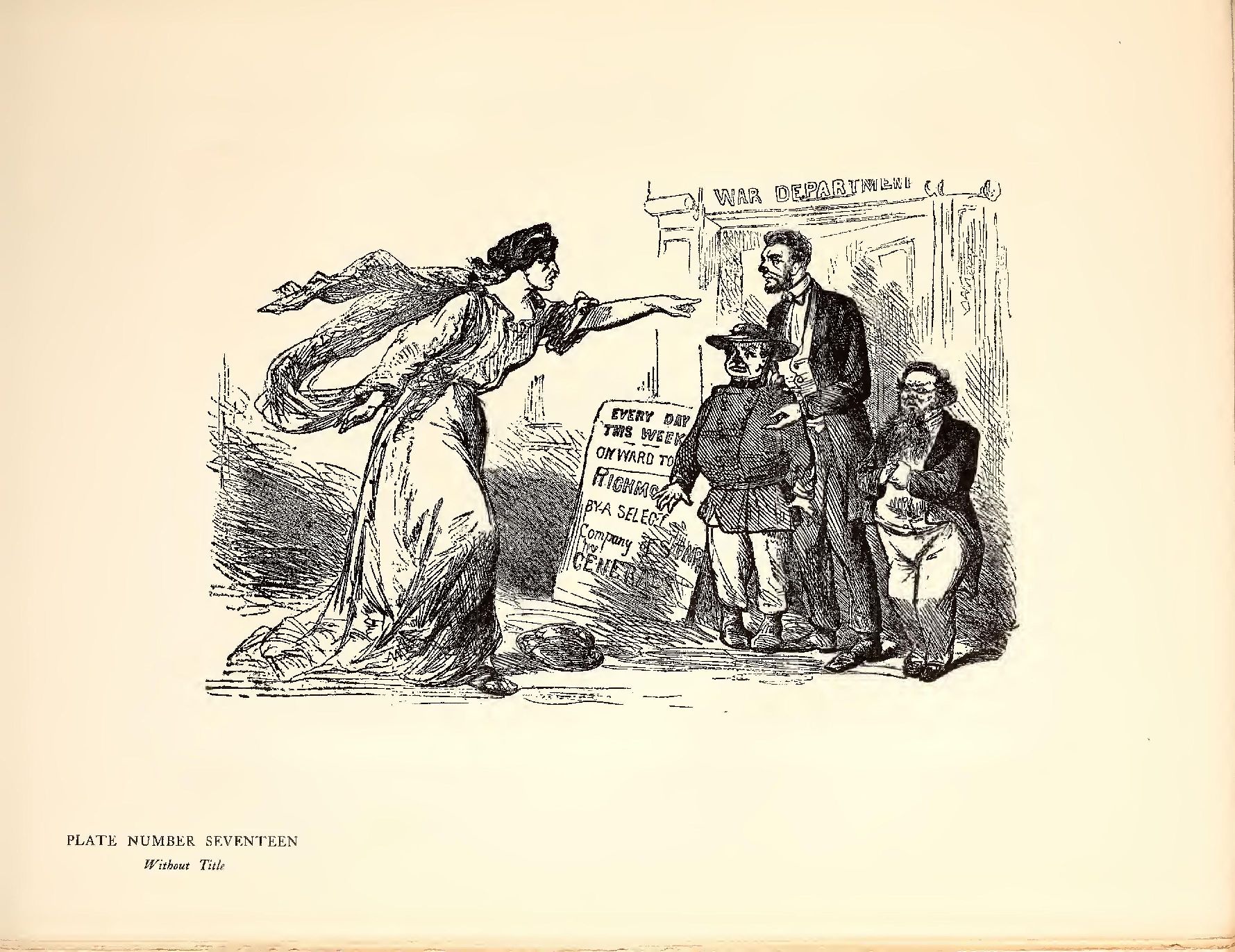
Plate Number Seventeen—This cartoon, without title, published in Harper's Weekly, on January 3, 1863, was prompted by the fearful Union slaughter at Fredericksburg. Columbia confronts the President and demands an accounting for the thousands slain in that conflict. "This reminds me of a little joke," Lincoln is made to say. "Go," is the angry rejoinder, "tell your joke at Springfield." Which calls to mind a story told the writer by the late Governor Curtin of Pennsylvania. It was after the battle of Fredericksburg, and Governor Curtin had gone to the front to look after his State's dead and wounded in person. While thus engaged he received a telegram from Lincoln bidding him come to Washington. He responded at once, and reaching the White House late in the evening found that the President had retired. Seated by the latter's bedside, he told what he had seen. "It was not a battle," said he; "it was, a slaughter. Many of the wounded have received no attention, and thousands of the dead are still unburied. From the bottom of my heart, Mr. President, I wish we could find some way of ending this war."
Lincoln listened patiently, but with manifest anxiety, to the Governor's statement. When it was finished, he said:
"Curtin, it's a big job we've got on hand. It reminds me of what once happened to the son of a friend of mine out in Illinois. There was an apple-tree in the old man's orchard of which he was especially choice, and one day in the fall his two boys, John and Jim, went out to gather the apples from this tree. John climbed the tree to shake the fruit off, while Jim remained below to gather it as it fell. There was a boar grubbing in the orchard, and seeing what was going on, it waddled up to the tree and began to eat the falling apples faster than Jim could gather them from the ground. This roiled Jim, and catching the boar by the tail he pulled vigorously, whereat the latter, with an angry squeal, began to snap at his legs. Afraid to let go, Jim held on for dear life, until finally, growing weary, he called to his brother to help him. John, from the top of the tree, asked what was wanted.'I want you,' said Jim, between the rushes of the boar,'to come down here and help me to let go of this darned hog's tail.' And Curtin," added the President, "that's just what I want of you and the rest: I want you to pitch in and help me let go of the hog's tail I have got hold of."
Before beginning this story Lincoln had been deeply depressed. When it was finished he laughed as heartily as did his auditor, and seemed instantly to recover his wonted spirits. "Pardon me, Mr. President," said the Governor, prompted by this change of mood, "but is not this story-telling habit of yours a sort of safety valve for you?"
"You have hit it, Curtin," was the quick reply. "If I could not tell these stories I think I should die."
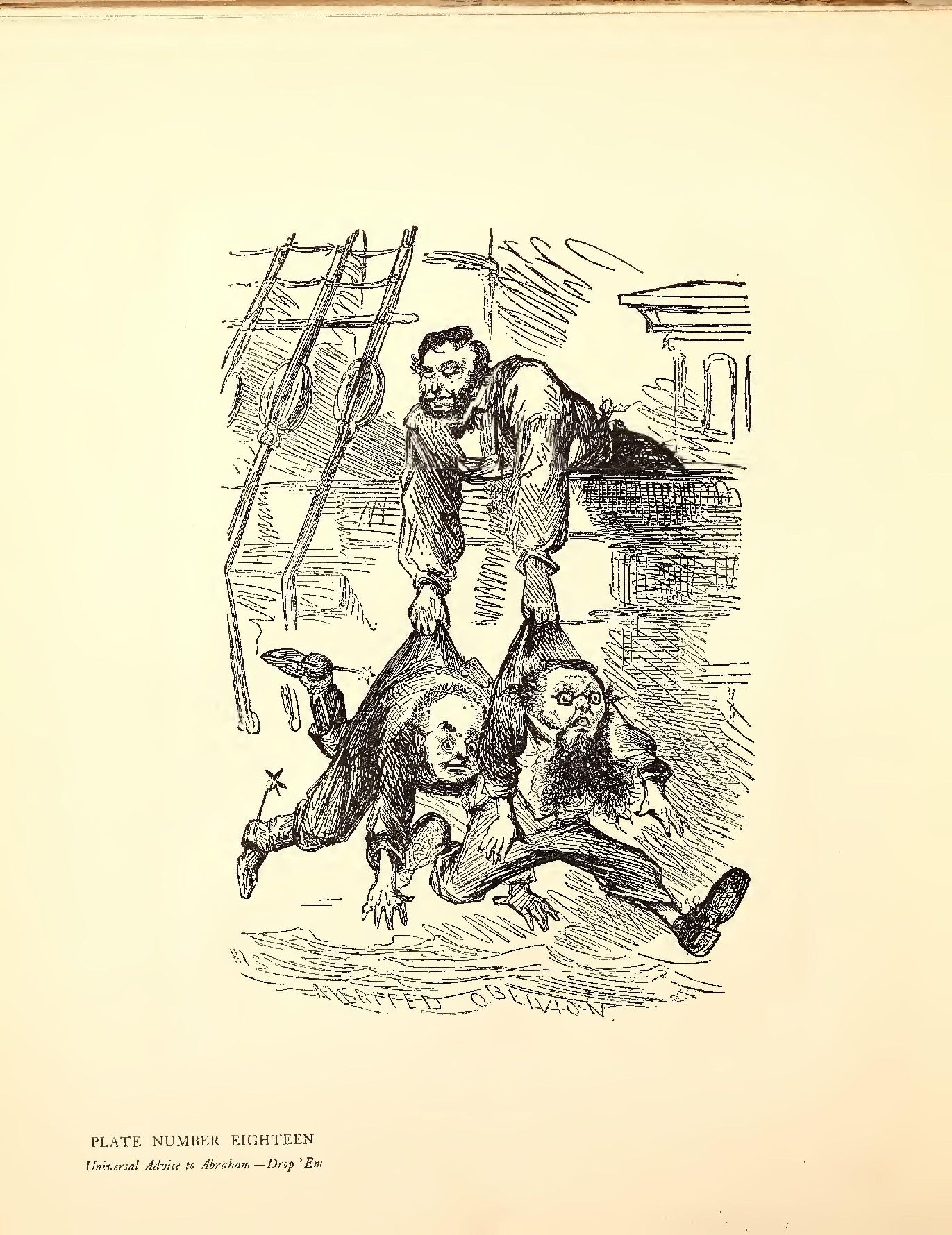
Plate Number Eighteen—This cartoon, published in Harper's Weekly, on January 10, 1863, also reflects the resentment provoked by the Fredericksburg fiasco, for which General Halleck and Secretary Stanton were at first held responsible in the popular mind. Lincoln is shown holding these officials over the side of the Ship of State. "Universal Advice to Abraham—Drop'Em," was the significant legend appended to this cartoon.
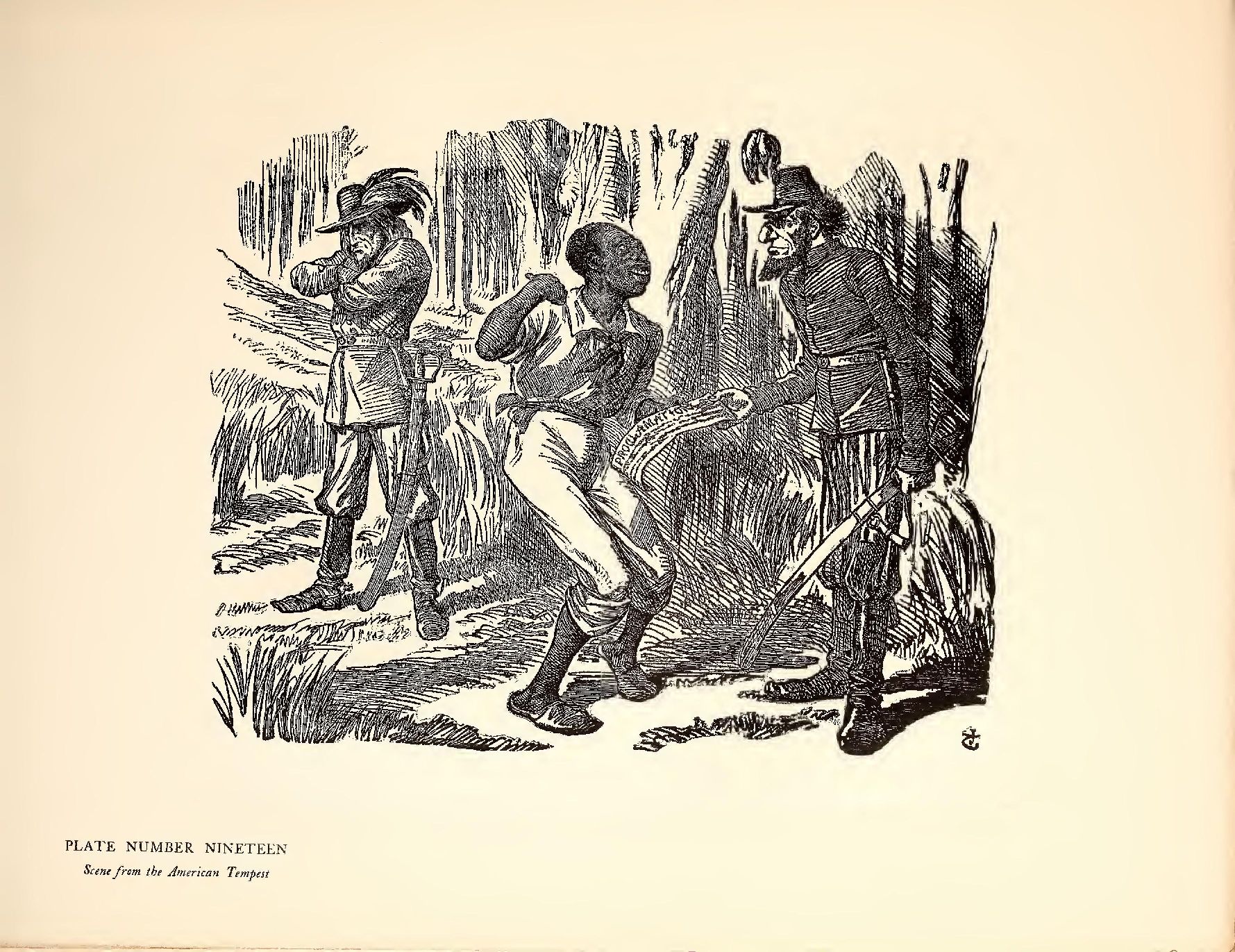
Plate Number Nineteen—This cartoon, "Scene from the American Tempest," published in Punch, on January 24, 1863, was prompted by the final Proclamation of Emancipation, issued on the first day of that year. The President, clad in the uniform of a Union soldier, hands a copy of his proclamation to a grinning negro, who points to a glowering Confederate in his rear and says: "You beat him'nough, Massa! Berry little time, I'll beat him too."
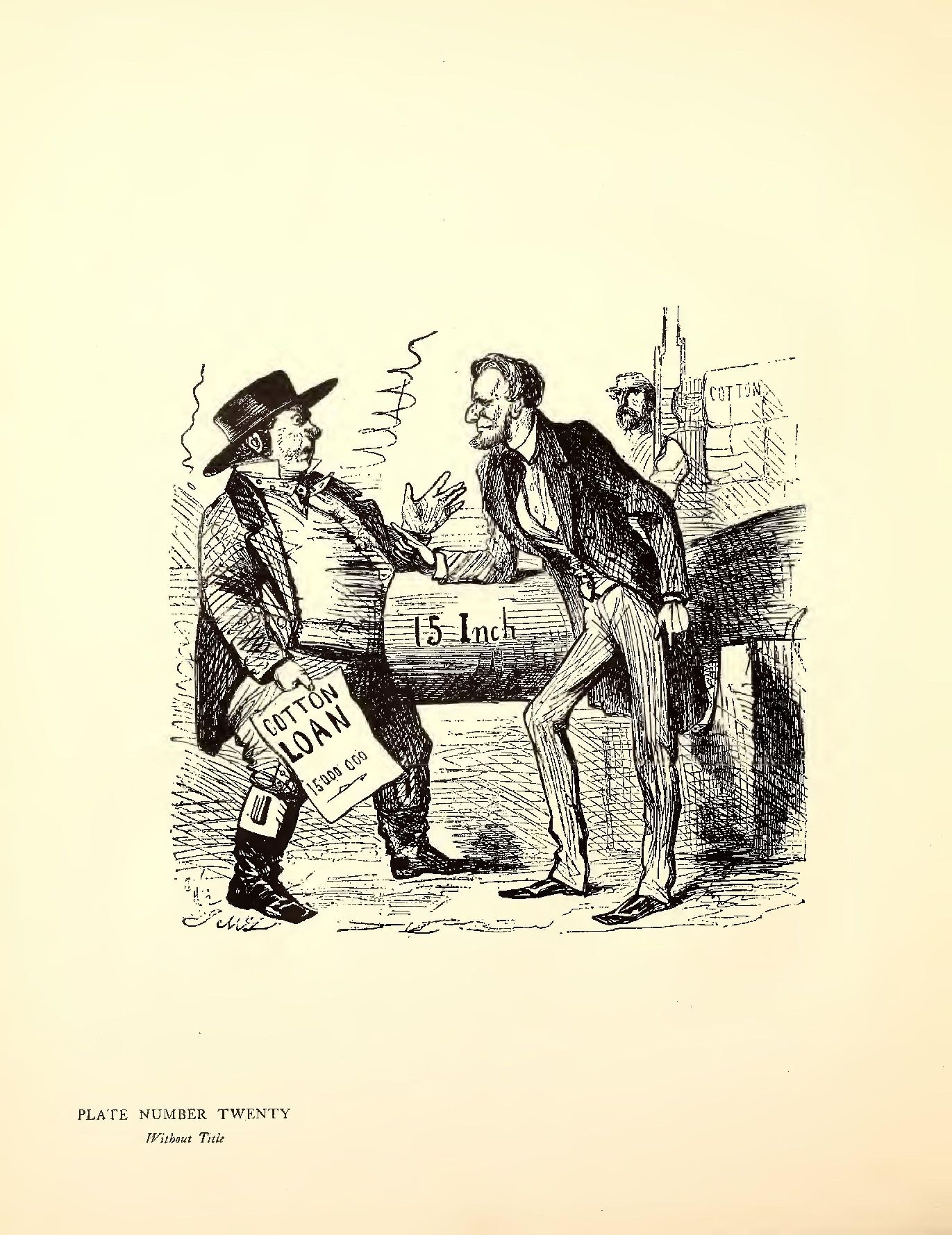
Plate Number Twenty—This cartoon, without title, was published in Harper's Weekly, on May 16, 1863. It deals with the underlying cause of England's unfriendly attitude toward the Union—the sudden shutting off of the supply of raw material for her cotton mills. Lincoln leans on a cannon and confronts John Bull in plaintive mood. "Hi want my cotton bought at fi'pence a pound," pleads the Briton. "Don't know anything about it, my dear sir," is the curt reply. "Your friends the rebels are burning all the cotton they find, and I confiscate the rest. Good morning, John."
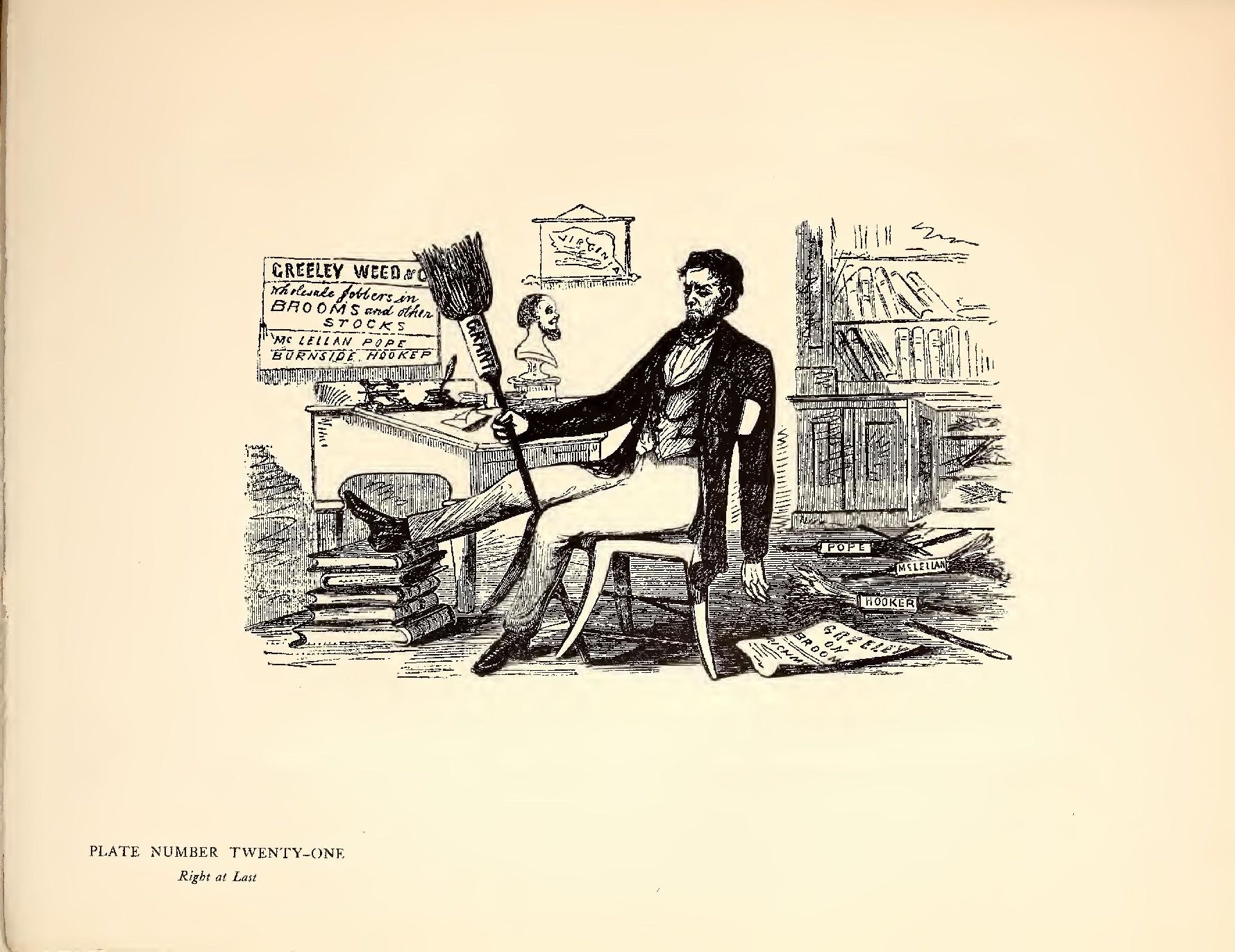
Plate Number Twenty-one—This cartoon, "Right at last," was published in Frank Leslie's Illustrated Newspaper, on June 13, 1863. Grant was still hammering at the defences of Vicksburg, with the outcome of his campaign in doubt, and the people of the North impatient and distrustful. The editor of the Tribune was especially earnest and insistent in the demand that his work should be given into other hands. The President, who holds in his hand a broom bearing Grant's name, is made to say: "Greeley be hanged! I want no more new brooms. I begin to think that the worst thing about my old ones was in not being handled right."
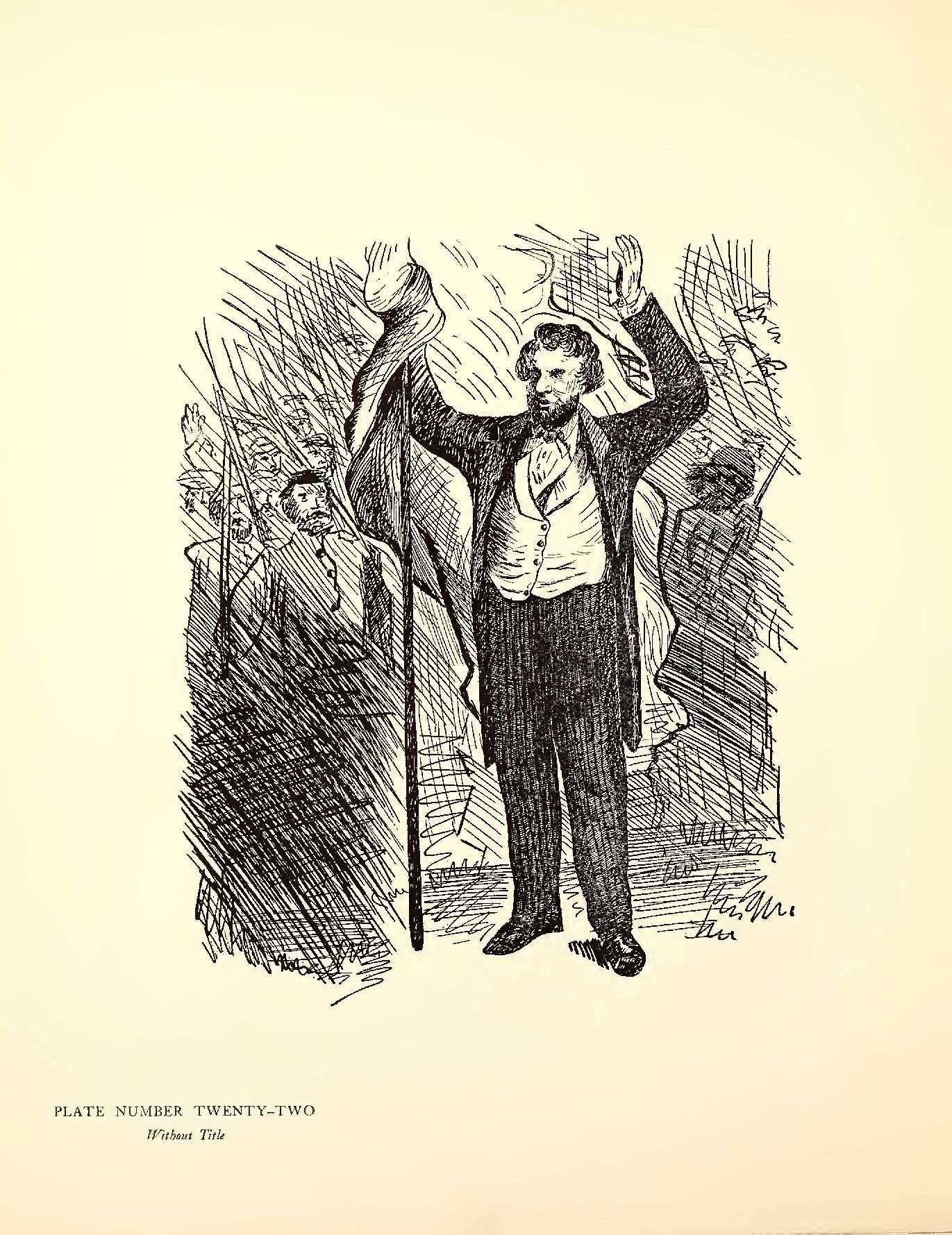
Plate Number Twenty-two—This cartoon, without title, was published in Vanity Fair, on July 4, 1863. When Lee invaded Pennsylvania to meet defeat at Gettysburg, the President called upon the States of New York, Pennsylvania, Maryland and West Virginia, for 120,000 men, for temporary use, and they were promptly supplied him. The design under review, in happy keeping with the day upon which it was issued, showed Lincoln holding aloft a flag and calling for volunteers, who are flocking to him from every side. This was the last time he was cartooned in Vanity Fair. A week later that journal ceased to exist.

Plate Number Twenty-three—This cartoon, "Rowdy Notions of Emancipation," published in Punch, on August 8, 1863, has for its subject the lamentable draft riots in New York City. A gang of rioters are shown beating one negro and another lies prostrate on the ground, while President Lincoln stands at one side, dismayed but apparently unwilling to put an end to the foul work going on at his elbow. Here Punch's artist is once more needlessly and manifestly unjust, for if any one deserved censure for the excesses of the draft riots, Horatio Seymour, then Governor of New York, not Lincoln, was the man upon whom the whip should have fallen.
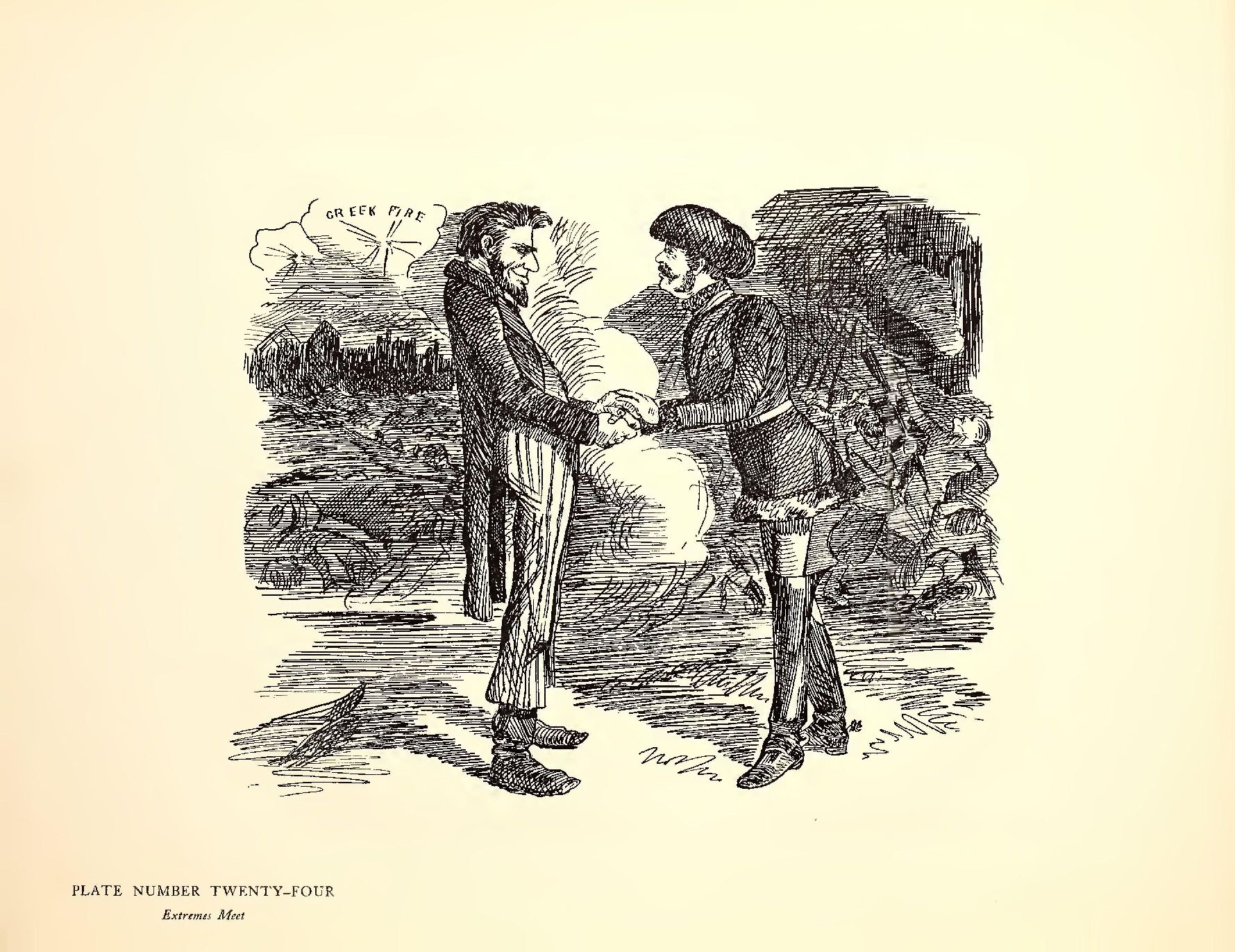
Plate Number Twenty-four—This cartoon, "Extremes Meet," was published in Punch, on October 24, 1868. The Polish insurrection was then in progress, and the American President and the Russian Czar are depicted triumphantly clasping hands in the foreground of an impressive picture of rapine and desolation. The result sought by the artist is made clear in the appended dialogue:
Abe—Imperial son of Nicholas the Great,
We air in the same fix, I calculate,
You with your Poles, with Southern rebels, I,
Who spurn my rule and my revenge defy.
Alex—Vengeance is mine, old man; see where it falls.
Behold yon hearths laid waste, and ruined walls,
Yon gibbets, where the struggling patriot hangs,
Whilst my brave myrmidons enjoy his pangs.
The Polish insurrection, then in progress, furnishes the motive of this cartoon, which serves to recall the good will shown by Russia for the Union, when it stood without other friends among the nations. How substantial was this good will furnishes the cue to a chapter in our history which yet remains to be written. A part of this chapter the writer once had from the lips of the late Simon Cameron, of Pennsylvania. Just before General Cameron went to Russia as American Minister in the early part of 1862 he was charged with a secret commission. He was directed, upon the presentation of his letters to the Russian Chancellor in St. Petersburg, to say that President Lincoln asked that the Minister might have a personal and confidential interview with the Czar. If this was accorded he should say to the Czar that the President was troubled about the possibility of interference by England or France in behalf of the Confederacy, and that if the friendship of Russia was such as to justify the monarch in conveying, confidentially, any intimation of his feelings and attitude in such a contingency, the President would be grateful. The interview was accorded, the message was delivered and the answer was cordial, and in about these words: "The friendship of Russia for the United States has long continued, and is such as to justify the President's request. The reply of Russia is ready. You will convey to Mr. Lincoln my personal regards, and say that the danger of interference by any European nation is exceedingly remote; but in that improbable contingency, or upon the appearance of real danger of it, the friendship of Russia for the United States will be made known in a decisive manner, which no other nation will be able to mistake."
This message was duly reported to the President. How the Czar kept his promise came out in an interview which he granted in 1879 to Wharton Barker, for many years Russian financial agent in America. He said to Barker: "In the autumn of 1862 France and England proposed to Russia in formal (but not in official) way, the joint recognition by European nations of the independence of the Confederate States. My immediate answer was:'I will not cooperate in such action, and I will not acquiesce; but, on the contrary, I shall accept recognition of the independence of the Confederate States as a casus belli for Russia, and that the governments of France and England may understand that this is no idle threat, I will send a Pacific fleet to San Francisco and an Atlantic fleet to New York.' Sealed orders were given to both admirals. My fleets arrived at the American ports, there was no recognition of the independence of the Confederate States by England and France, the American rebellion was put down and the great American republic continues. All this I did because of love for my own dear Russia. I acted thus because I understood that Russia would have a more serious task to perform if the American republic, with advanced industrial development, was broken up and England left in control of most branches of modern industrial development."
It was England's warm resentment of Russia's attitude that prompted the cartoon under consideration. Even more pronounced in its mocking cynicism was Punch's cartoon for November 7, 1863. The tacit alliance between Russia and the United States still grated upon English sensibilities, and the artist provoked the multitude to laughter by depicting the President as Mephistopheles saluting the Russian bear. Hard things in plenty were said of Lincoln, both at home and abroad, but this is the only instance in which he was portrayed in Satan's livery. British malice could go no further than this.

Plate Number Twenty-five—This cartoon, "Drawing Things to a Head," published in Harper's Weekly, on November 28, 1863, shows how the friendship of Russia was regarded in the loyal States. Lincoln, ensconced in a snug apothecary shop, watched from the opposite side of the street by John Bull and Napoleon, is made to say to Secretary Seward, who is presented as an errand boy with a basket of Russian salve on his arm: "Mild applications of Russian salve for our friends over the way, and heavy doses and plenty of it for our Southern patient."
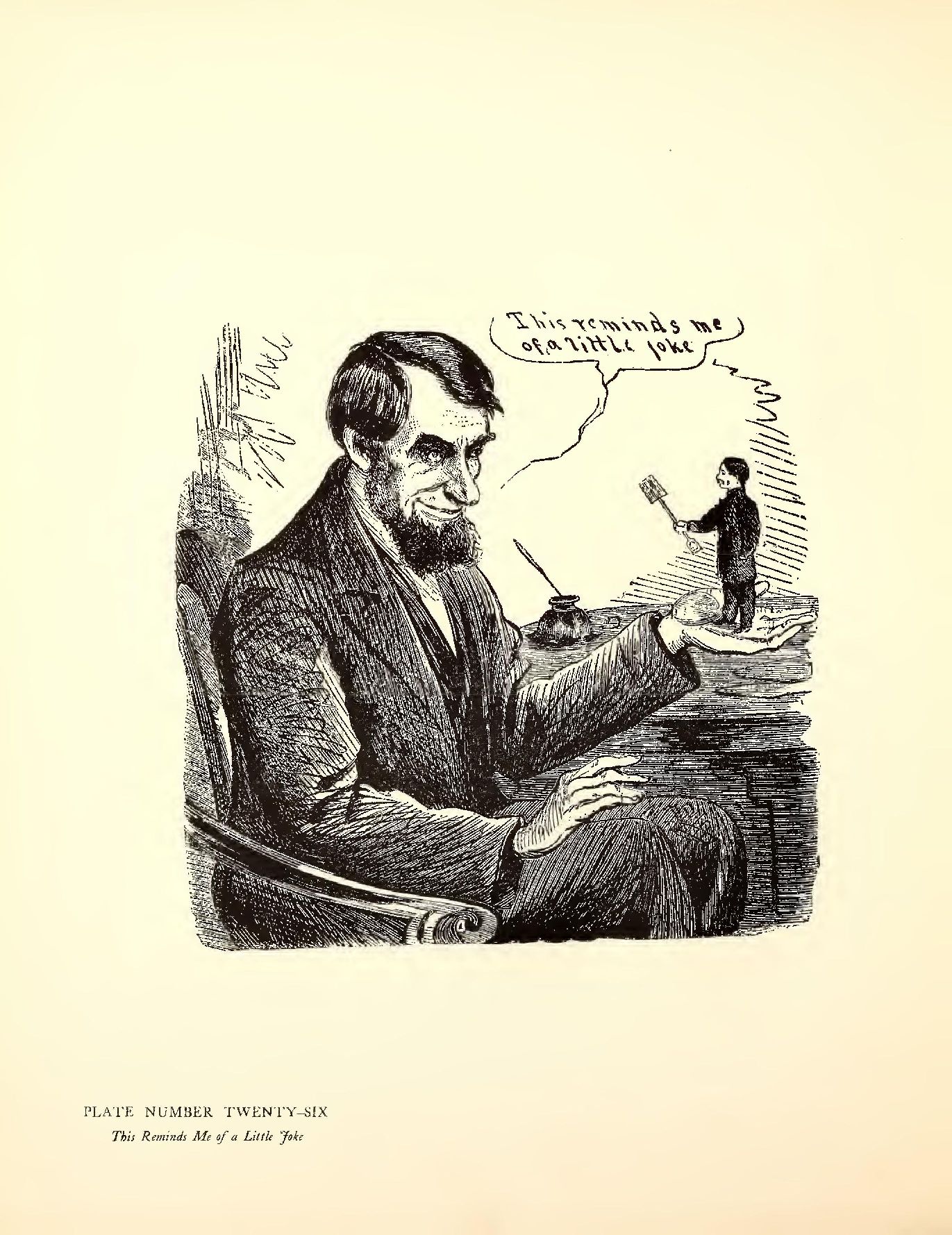
Plate Number Twenty-six—This cartoon, "This Reminds Me of a Little Joke," published in Harper's Weekly, on September 17, 1864, recalls the extraordinary Presidential campaign of that year. There was, during the opening months of 1864, a determined and more or less noisy opposition to the renomination of Lincoln. This came from two sources—the radical abolitionists, who chafed at what they called the President's half-hearted policy in regard to slavery, and another element, which, while supporting the Union, believed that slavery should be let alone; but it shrank into insignificance as time went on, and when the Republican Convention met at Baltimore on June 7, Lincoln was renominated on the first ballot. The Democratic National Convention was held twelve weeks later in Chicago. A few days before it met President Lincoln said to a friend: "They must nominate a peace Democrat on a war platform, or a war Democrat on a peace platform." The convention chose the second of these alternatives. It adopted a platform which declared the war a failure and demanded an immediate cessation of hostilities, and it nominated for President the best known of all the war Democrats, General George B. McClellan. The latter's chances of election, whatever they may have been, disappeared within a fortnight of his nomination. The course of the war during the summer had been studded thickly with bloody and seemingly indecisive battles. Both in the East and the West the opposing armies were grinding in almost continuous struggle. But Sherman's capture of Atlanta and Farra-gut's entrance into Mobile harbor, proved to the people of the North that the end was in sight, and when the President called for five hundred thousand more men they came forward rapidly, a large and valuable percentage of them being volunteers who had served their time under previous enlistments. Long before election day it was evident that no prospect remained of Democratic success. When the polls were closed and the votes counted, Lincoln's enormous popular majority of more than 400,000 fairly buried the McClellan electoral tickets. Kentucky and Delaware, with New Jersey, testified their disgust with Emancipation, but they were of small account in an electoral college of 233 votes, wherein 212 were solidly against them.
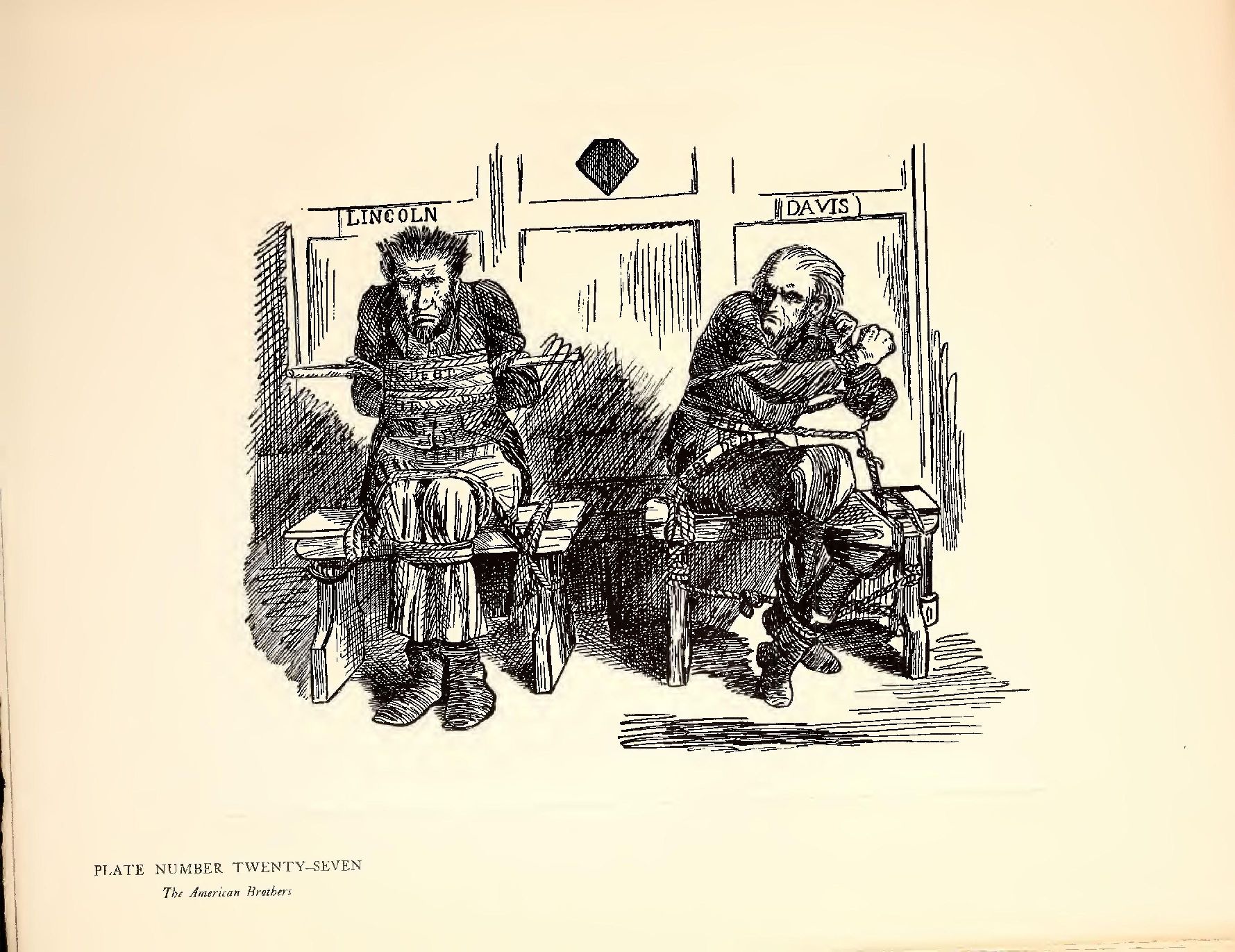
Plate Number Twenty-seven—This cartoon, "The American Brothers; or, How Will They Get Out of It," was published in Punch on November 5, 1864. It has, in the light of after events, a touch of humor not intended by the artist. When it was drawn, the belief was generally prevalent in England that Lincoln's defeat at the coming election was a foregone conclusion. Thus, this cartoon pictures Lincoln and Davis bound to adjacent benches by ropes, significantly labelled "Debts," but it was still wet from the press when Lincoln, as we have just seen, was re-elected by the largest majority in the electoral college ever given to a candidate.

Plate Number Twenty-eight—This cartoon, "Long Abraham Lincoln a Little Longer," published in Harper's Weekly, on November 26, 1864, tells its own story and bears witness to the joyful relief with which the people of the North greeted the re-election of Lincoln. Very like the foregoing in spirit and treatment (and for that reason not reproduced in this place) is a cartoon published in Frank Leslie's Illustrated Newspaper on December 3, 1864. It bears title, "Jeff Davis' November Nightmare," and places the President, with legs drawn up, on the bed of the Confederate leader. "Is that you still there, Long Abe?" asks the suddenly awakened man. "Yes, and I am going to be four years longer," is the reply.
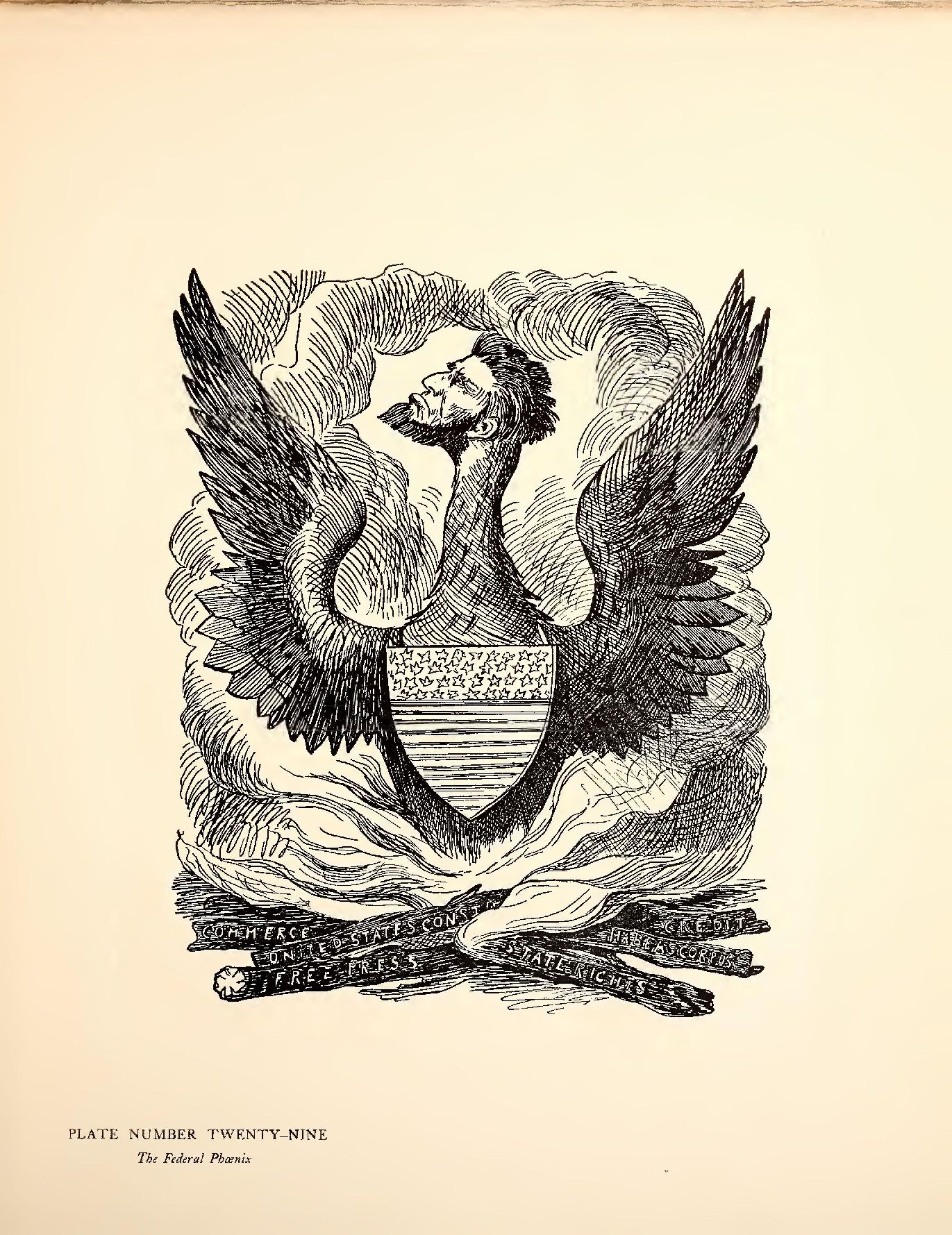
Plate Number Twenty-nine—This cartoon, "The Federal Phoenix," was published in Punch, on December 3, 1864. Its character is explained in its title, and it shows one of those fabled birds, on which the artist has placed the head of Lincoln, rising from a pyre, the fuel for which is furnished by commerce, credit, the Constitution, a free press, habeas corpus and State rights. How it impressed the public for whom it was intended can only be conjectured, but to the eyes of an American, a generation after the death of the man whom it thus held up to condemnation, it seems as brutal in motive as it is misleading in fact.

Plate Number Thirty—This-cartoon, "The Threatening Notice," published in Punch, on February 26, 1865, represents Lincoln remonstrating with the American eagle in the dress of Uncle Sam over the Senate's proposed abrogation of Canadian treaties. "Now, Uncle Sam," the President is reported as saying, "you're in a darned hurry to serve this notice on John Bull. Now, it's my duty as your attorney, to tell you that you may drive him to go over to that cuss, Davis." But John Bull was not to be driven "over to that cuss, Davis." Two months later the war was ended, and Lincoln dead. Punch has caricatured him for the last time.
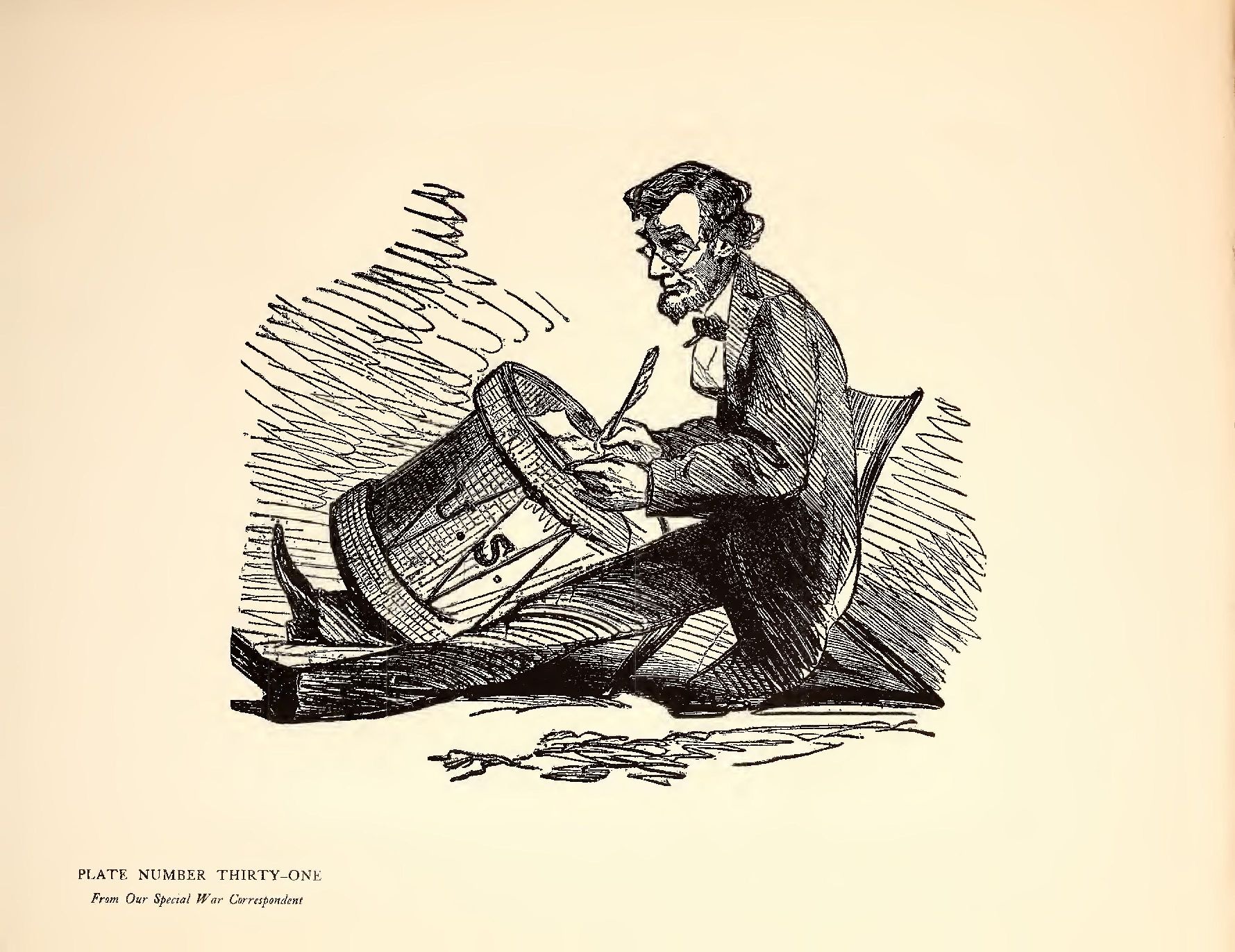
Plate Number Thirty-one—This cartoon, "From Our Special War Correspondent," was published in Harper's Weekly, on April 15, 1865. Lincoln, who had lately made his last visit to the front, was represented, with a drumhead for a table, writing from City Point, Virginia: "All seems well with us." These words, in the light of after events, are not without a touch of pathos. When the journal in which they appeared reached its readers, Booth's bullet had done its work and Lincoln had become the gentlest memory in our history.
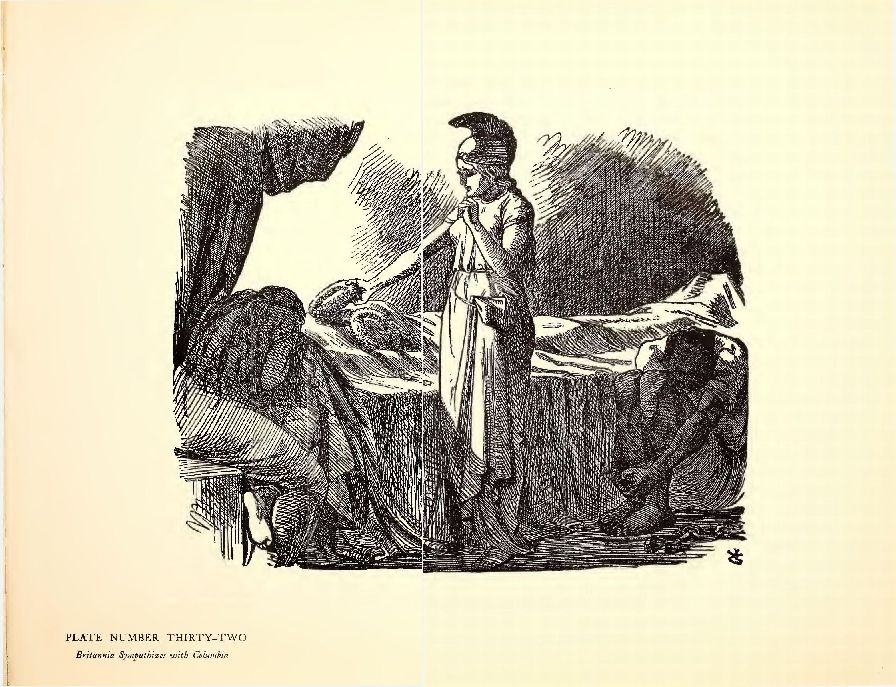
Plate Number Thirty-two—This cartoon, "Britannia Sympathizes with Columbia," published in Punch, on May 6,1865, testifies to the world-wide grief which attended the death of the great war President, and shows how strong had become his hold upon all men who love brave deeds and honest lives. Britons had not hesitated to criticise and upbraid him living, but dead they were quick to recognize him as the noblest, knightliest figure of an age rich above all things else in the number and grandeur of its great men.
It has been impossible to trace the authorship of most of the cartoons herewith reproduced from Harper s Weekly and Frank Leslie's Illustrated Newspaper, but three of them, at least, are known to be from the pencil of the elder Frank Bellew, an English artist who came to this country to embark with John Brougham in the publication of a short-lived weekly, called the Lantern, later helping to found half a dozen other periodicals. Bellew had cleverness and versatility, and a rich vein of humor, as the drawings "Sinbad Lincoln and the Old Man of the Sea," "Lincoln's Last Warning" and "Long Abraham a Little Longer" bear witness, but he failed to achieve complete success in his work, and left no impress upon the political thought of his time.
The designer of a majority of the cartoons reproduced from Vanity Fair, which, between 1859 and 1863, ran a checkered but lively existence, was the late Henry Louis Stephens, a man of fertile and incisive wit, with unusual ability to enforce a pictorial moral by simple yet telling methods. For a brief period Mr. Stephens's attitude toward Lincoln seems to have been touched by the not always good-natured suspicion with which the public regards a new and comparatively untried man; but no sooner had Sumter been fired upon than the artist and his journal became ardent and unswerving in their support of the Union, and so continued until the end. Stephens's drawings, though somewhat crude and faulty in method, are, nevertheless, notable for their originality and force. He lacked, however, either the inclination or the opportunity to continue in the field for which he had shown so marked an aptitude, and long before his death, in 1883, fallen into obscurity.
All of the cartoons reproduced from London Punch are from the pencil of Sir John Tenniel, who, in 1901, concluded half a century of brilliant service on that journal. Tenniel was already an artist of repute when he joined the staff of Punch in 1851, and for many years preceding his self-sought retirement he was recognized as incomparably the greatest caricaturist of his time—his pencil a force to be taken into account by sagacious statesmen in every forecast of the drift of public opinion. His range is not a wide one, yet within its clearly defined limits he is nearly always powerful. Although his methods are usually simple, through them he secures signal breadth and strength, while now and then he gives an impression of power such as one fancies an Angelo might have given had he amused himself by drawings reflecting upon the politics of his time. If there was any doubt in official minds respecting the necessity of sending an army to the rescue of Khartoum, it vanished when Tenniel drew his picture of General Gordon standing behind an earthwork and looking across the desert for a glimpse of the expected redcoats. That touched the heart of England, and was more potent than the fiercest denunciation from the Opposition bench of the Gladstone ministry's inaction in the Soudan.
Tenniel is first of all a satirist, but he has seldom been either unjust or unfair in his work. His longest and most memorable departure from fairness was when, in common with the ruling class of England generally, he misinterpreted our Civil War and caricatured the chief actor therein with astonishing perversity. Still, he was not more frequently or more deeply in the wrong than some of our own politicians, who could not plead his excuse of distance from the scene, and, to his credit, be it said, when once convinced of his error he made prompt and generous amends therefor. Nothing could have been more fitting nor finer in its way than his design, already referred to, which showed Britannia laying a wreath on the bier of the martyred President and which was accompanied by these appreciative lines from the pen of Tom Taylor:
You lay a wreath on murdered Lincoln's bier,
You, who with mocking pencil wont to trace,
Brood for the self-complacent British sneer,
His length of shambling limb, his furrowed face,
His gaunt, gnarled hands, his unkept, bristling hair,
His garb uncouth, his bearing ill at ease,
His lack of all we prize as debonair,
Of power or will to shine, of art to please.
You, whose smart pen backed up the pencil's laugh,
Judging each step as though the way were plain;
Reckless, so it could point its paragraph,
Of chief's perplexity, or people's pain.
Beside this corpse that bears for winding sheet
The stars and stripes he lived to rear anew;
Between the mourners at his head and feet,
Say, scurril jester, is there room for you?
Yes, he has lived to shame me for my sneer,
To lame my pencil and confute my pen—
To make me own this hind of princes peer,
This rail-splitter, a true-born king of men.
My shallow judgment I have learned to rue,
Noting how to occasion's height he rose;
How his quaint wit made home-truth seem more true,
How, iron-like, his temper grew by blows.
How humble yet how hopeful he could be;
How in good fortune and in ill the same;
Nor bitter in success nor boastful he,
Thirsty for gold, nor feverish for fame.
He went about his work, such work as few
Ever had laid on head and heart and hand,
As one who knows where there's a task to do,
Man's honest will must Heaven's good grace command;
Who trusts the strength will with the burden grow,
That God makes instruments to work His will,
If but that will we can arrive to know,
Nor tamper with the weights of good and ill.
So he went forth to battle on the side
That he felt clear was Liberty's and Right's,
As in his peasant boyhood he had plied
His warfare with rude Nature's thwarting mights;
The uncleared forest, the unbroken soil,
The iron-bark that turns the lumberer's ax,
The rapid that o'erbears the boatman's toil,
The prairie, hiding the mazed wanderer's tracks,
The ambushed Indian and the prowling bear—
Such were the deeds that helped his youth to train:
Rough culture, but such trees large fruit may bear,
If but their stocks be of right girth and grain.
So he grew up, a destined work to do,
And lived to do it; four long-suffering years'
Ill-fate, ill-feeling, ill-report, lived through,
And then he heard the hisses changed to cheers,
The taunts to tribute, the abuse to praise,
And took both with the same unwavering mood;
Till, as he came on light, from darkling days,
And seemed to touch the goal from where he stood,
A felon hand, between the goal and him,
Reached from behind his back, a trigger prest,
And those perplexed and patient eyes were dim,
Those gaunt, long-laboring limbs were laid to rest!
The words of mercy were upon his lips,
Forgiveness in his heart and on his pen,
When his vile murderer brought swift eclipse
To thoughts of peace on earth, good will to men.
The Old World and the New, from sea to sea,
Utter one voice of sympathy and shame!
Sore heart, so stopped when it at last beat high,
Sad life, cut short, just as its triumph came.
A deed accurst! Strokes have been struck before
By the assassin's hand, whereof men doubt
If more of honor or disgrace they bore;
But thy foul crime, like Cain's, stands darkly out.
Vile hand, that brandest murder on a strife,
Whate'er its grounds, stoutly and nobly driven;
And with the martyr's crown crownest a life,
With much to praise, little to be forgiven.
End of Project Gutenberg's Lincoln in Caricature, by Rufus Rockwell Wilson
*** END OF THIS PROJECT GUTENBERG EBOOK LINCOLN IN CARICATURE ***
***** This file should be named 45069-h.htm or 45069-h.zip *****
This and all associated files of various formats will be found in:
http://www.gutenberg.org/4/5/0/6/45069/
Produced by David Widger from page images generously
provided by The Internet Archive
Updated editions will replace the previous one--the old editions
will be renamed.
Creating the works from public domain print editions means that no
one owns a United States copyright in these works, so the Foundation
(and you!) can copy and distribute it in the United States without
permission and without paying copyright royalties. Special rules,
set forth in the General Terms of Use part of this license, apply to
copying and distributing Project Gutenberg-tm electronic works to
protect the PROJECT GUTENBERG-tm concept and trademark. Project
Gutenberg is a registered trademark, and may not be used if you
charge for the eBooks, unless you receive specific permission. If you
do not charge anything for copies of this eBook, complying with the
rules is very easy. You may use this eBook for nearly any purpose
such as creation of derivative works, reports, performances and
research. They may be modified and printed and given away--you may do
practically ANYTHING with public domain eBooks. Redistribution is
subject to the trademark license, especially commercial
redistribution.
*** START: FULL LICENSE ***
THE FULL PROJECT GUTENBERG LICENSE
PLEASE READ THIS BEFORE YOU DISTRIBUTE OR USE THIS WORK
To protect the Project Gutenberg-tm mission of promoting the free
distribution of electronic works, by using or distributing this work
(or any other work associated in any way with the phrase "Project
Gutenberg"), you agree to comply with all the terms of the Full Project
Gutenberg-tm License available with this file or online at
www.gutenberg.org/license.
Section 1. General Terms of Use and Redistributing Project Gutenberg-tm
electronic works
1.A. By reading or using any part of this Project Gutenberg-tm
electronic work, you indicate that you have read, understand, agree to
and accept all the terms of this license and intellectual property
(trademark/copyright) agreement. If you do not agree to abide by all
the terms of this agreement, you must cease using and return or destroy
all copies of Project Gutenberg-tm electronic works in your possession.
If you paid a fee for obtaining a copy of or access to a Project
Gutenberg-tm electronic work and you do not agree to be bound by the
terms of this agreement, you may obtain a refund from the person or
entity to whom you paid the fee as set forth in paragraph 1.E.8.
1.B. "Project Gutenberg" is a registered trademark. It may only be
used on or associated in any way with an electronic work by people who
agree to be bound by the terms of this agreement. There are a few
things that you can do with most Project Gutenberg-tm electronic works
even without complying with the full terms of this agreement. See
paragraph 1.C below. There are a lot of things you can do with Project
Gutenberg-tm electronic works if you follow the terms of this agreement
and help preserve free future access to Project Gutenberg-tm electronic
works. See paragraph 1.E below.
1.C. The Project Gutenberg Literary Archive Foundation ("the Foundation"
or PGLAF), owns a compilation copyright in the collection of Project
Gutenberg-tm electronic works. Nearly all the individual works in the
collection are in the public domain in the United States. If an
individual work is in the public domain in the United States and you are
located in the United States, we do not claim a right to prevent you from
copying, distributing, performing, displaying or creating derivative
works based on the work as long as all references to Project Gutenberg
are removed. Of course, we hope that you will support the Project
Gutenberg-tm mission of promoting free access to electronic works by
freely sharing Project Gutenberg-tm works in compliance with the terms of
this agreement for keeping the Project Gutenberg-tm name associated with
the work. You can easily comply with the terms of this agreement by
keeping this work in the same format with its attached full Project
Gutenberg-tm License when you share it without charge with others.
1.D. The copyright laws of the place where you are located also govern
what you can do with this work. Copyright laws in most countries are in
a constant state of change. If you are outside the United States, check
the laws of your country in addition to the terms of this agreement
before downloading, copying, displaying, performing, distributing or
creating derivative works based on this work or any other Project
Gutenberg-tm work. The Foundation makes no representations concerning
the copyright status of any work in any country outside the United
States.
1.E. Unless you have removed all references to Project Gutenberg:
1.E.1. The following sentence, with active links to, or other immediate
access to, the full Project Gutenberg-tm License must appear prominently
whenever any copy of a Project Gutenberg-tm work (any work on which the
phrase "Project Gutenberg" appears, or with which the phrase "Project
Gutenberg" is associated) is accessed, displayed, performed, viewed,
copied or distributed:
This eBook is for the use of anyone anywhere at no cost and with
almost no restrictions whatsoever. You may copy it, give it away or
re-use it under the terms of the Project Gutenberg License included
with this eBook or online at www.gutenberg.org
1.E.2. If an individual Project Gutenberg-tm electronic work is derived
from the public domain (does not contain a notice indicating that it is
posted with permission of the copyright holder), the work can be copied
and distributed to anyone in the United States without paying any fees
or charges. If you are redistributing or providing access to a work
with the phrase "Project Gutenberg" associated with or appearing on the
work, you must comply either with the requirements of paragraphs 1.E.1
through 1.E.7 or obtain permission for the use of the work and the
Project Gutenberg-tm trademark as set forth in paragraphs 1.E.8 or
1.E.9.
1.E.3. If an individual Project Gutenberg-tm electronic work is posted
with the permission of the copyright holder, your use and distribution
must comply with both paragraphs 1.E.1 through 1.E.7 and any additional
terms imposed by the copyright holder. Additional terms will be linked
to the Project Gutenberg-tm License for all works posted with the
permission of the copyright holder found at the beginning of this work.
1.E.4. Do not unlink or detach or remove the full Project Gutenberg-tm
License terms from this work, or any files containing a part of this
work or any other work associated with Project Gutenberg-tm.
1.E.5. Do not copy, display, perform, distribute or redistribute this
electronic work, or any part of this electronic work, without
prominently displaying the sentence set forth in paragraph 1.E.1 with
active links or immediate access to the full terms of the Project
Gutenberg-tm License.
1.E.6. You may convert to and distribute this work in any binary,
compressed, marked up, nonproprietary or proprietary form, including any
word processing or hypertext form. However, if you provide access to or
distribute copies of a Project Gutenberg-tm work in a format other than
"Plain Vanilla ASCII" or other format used in the official version
posted on the official Project Gutenberg-tm web site (www.gutenberg.org),
you must, at no additional cost, fee or expense to the user, provide a
copy, a means of exporting a copy, or a means of obtaining a copy upon
request, of the work in its original "Plain Vanilla ASCII" or other
form. Any alternate format must include the full Project Gutenberg-tm
License as specified in paragraph 1.E.1.
1.E.7. Do not charge a fee for access to, viewing, displaying,
performing, copying or distributing any Project Gutenberg-tm works
unless you comply with paragraph 1.E.8 or 1.E.9.
1.E.8. You may charge a reasonable fee for copies of or providing
access to or distributing Project Gutenberg-tm electronic works provided
that
- You pay a royalty fee of 20% of the gross profits you derive from
the use of Project Gutenberg-tm works calculated using the method
you already use to calculate your applicable taxes. The fee is
owed to the owner of the Project Gutenberg-tm trademark, but he
has agreed to donate royalties under this paragraph to the
Project Gutenberg Literary Archive Foundation. Royalty payments
must be paid within 60 days following each date on which you
prepare (or are legally required to prepare) your periodic tax
returns. Royalty payments should be clearly marked as such and
sent to the Project Gutenberg Literary Archive Foundation at the
address specified in Section 4, "Information about donations to
the Project Gutenberg Literary Archive Foundation."
- You provide a full refund of any money paid by a user who notifies
you in writing (or by e-mail) within 30 days of receipt that s/he
does not agree to the terms of the full Project Gutenberg-tm
License. You must require such a user to return or
destroy all copies of the works possessed in a physical medium
and discontinue all use of and all access to other copies of
Project Gutenberg-tm works.
- You provide, in accordance with paragraph 1.F.3, a full refund of any
money paid for a work or a replacement copy, if a defect in the
electronic work is discovered and reported to you within 90 days
of receipt of the work.
- You comply with all other terms of this agreement for free
distribution of Project Gutenberg-tm works.
1.E.9. If you wish to charge a fee or distribute a Project Gutenberg-tm
electronic work or group of works on different terms than are set
forth in this agreement, you must obtain permission in writing from
both the Project Gutenberg Literary Archive Foundation and Michael
Hart, the owner of the Project Gutenberg-tm trademark. Contact the
Foundation as set forth in Section 3 below.
1.F.
1.F.1. Project Gutenberg volunteers and employees expend considerable
effort to identify, do copyright research on, transcribe and proofread
public domain works in creating the Project Gutenberg-tm
collection. Despite these efforts, Project Gutenberg-tm electronic
works, and the medium on which they may be stored, may contain
"Defects," such as, but not limited to, incomplete, inaccurate or
corrupt data, transcription errors, a copyright or other intellectual
property infringement, a defective or damaged disk or other medium, a
computer virus, or computer codes that damage or cannot be read by
your equipment.
1.F.2. LIMITED WARRANTY, DISCLAIMER OF DAMAGES - Except for the "Right
of Replacement or Refund" described in paragraph 1.F.3, the Project
Gutenberg Literary Archive Foundation, the owner of the Project
Gutenberg-tm trademark, and any other party distributing a Project
Gutenberg-tm electronic work under this agreement, disclaim all
liability to you for damages, costs and expenses, including legal
fees. YOU AGREE THAT YOU HAVE NO REMEDIES FOR NEGLIGENCE, STRICT
LIABILITY, BREACH OF WARRANTY OR BREACH OF CONTRACT EXCEPT THOSE
PROVIDED IN PARAGRAPH 1.F.3. YOU AGREE THAT THE FOUNDATION, THE
TRADEMARK OWNER, AND ANY DISTRIBUTOR UNDER THIS AGREEMENT WILL NOT BE
LIABLE TO YOU FOR ACTUAL, DIRECT, INDIRECT, CONSEQUENTIAL, PUNITIVE OR
INCIDENTAL DAMAGES EVEN IF YOU GIVE NOTICE OF THE POSSIBILITY OF SUCH
DAMAGE.
1.F.3. LIMITED RIGHT OF REPLACEMENT OR REFUND - If you discover a
defect in this electronic work within 90 days of receiving it, you can
receive a refund of the money (if any) you paid for it by sending a
written explanation to the person you received the work from. If you
received the work on a physical medium, you must return the medium with
your written explanation. The person or entity that provided you with
the defective work may elect to provide a replacement copy in lieu of a
refund. If you received the work electronically, the person or entity
providing it to you may choose to give you a second opportunity to
receive the work electronically in lieu of a refund. If the second copy
is also defective, you may demand a refund in writing without further
opportunities to fix the problem.
1.F.4. Except for the limited right of replacement or refund set forth
in paragraph 1.F.3, this work is provided to you 'AS-IS', WITH NO OTHER
WARRANTIES OF ANY KIND, EXPRESS OR IMPLIED, INCLUDING BUT NOT LIMITED TO
WARRANTIES OF MERCHANTABILITY OR FITNESS FOR ANY PURPOSE.
1.F.5. Some states do not allow disclaimers of certain implied
warranties or the exclusion or limitation of certain types of damages.
If any disclaimer or limitation set forth in this agreement violates the
law of the state applicable to this agreement, the agreement shall be
interpreted to make the maximum disclaimer or limitation permitted by
the applicable state law. The invalidity or unenforceability of any
provision of this agreement shall not void the remaining provisions.
1.F.6. INDEMNITY - You agree to indemnify and hold the Foundation, the
trademark owner, any agent or employee of the Foundation, anyone
providing copies of Project Gutenberg-tm electronic works in accordance
with this agreement, and any volunteers associated with the production,
promotion and distribution of Project Gutenberg-tm electronic works,
harmless from all liability, costs and expenses, including legal fees,
that arise directly or indirectly from any of the following which you do
or cause to occur: (a) distribution of this or any Project Gutenberg-tm
work, (b) alteration, modification, or additions or deletions to any
Project Gutenberg-tm work, and (c) any Defect you cause.
Section 2. Information about the Mission of Project Gutenberg-tm
Project Gutenberg-tm is synonymous with the free distribution of
electronic works in formats readable by the widest variety of computers
including obsolete, old, middle-aged and new computers. It exists
because of the efforts of hundreds of volunteers and donations from
people in all walks of life.
Volunteers and financial support to provide volunteers with the
assistance they need are critical to reaching Project Gutenberg-tm's
goals and ensuring that the Project Gutenberg-tm collection will
remain freely available for generations to come. In 2001, the Project
Gutenberg Literary Archive Foundation was created to provide a secure
and permanent future for Project Gutenberg-tm and future generations.
To learn more about the Project Gutenberg Literary Archive Foundation
and how your efforts and donations can help, see Sections 3 and 4
and the Foundation information page at www.gutenberg.org
Section 3. Information about the Project Gutenberg Literary Archive
Foundation
The Project Gutenberg Literary Archive Foundation is a non profit
501(c)(3) educational corporation organized under the laws of the
state of Mississippi and granted tax exempt status by the Internal
Revenue Service. The Foundation's EIN or federal tax identification
number is 64-6221541. Contributions to the Project Gutenberg
Literary Archive Foundation are tax deductible to the full extent
permitted by U.S. federal laws and your state's laws.
The Foundation's principal office is located at 4557 Melan Dr. S.
Fairbanks, AK, 99712., but its volunteers and employees are scattered
throughout numerous locations. Its business office is located at 809
North 1500 West, Salt Lake City, UT 84116, (801) 596-1887. Email
contact links and up to date contact information can be found at the
Foundation's web site and official page at www.gutenberg.org/contact
For additional contact information:
Dr. Gregory B. Newby
Chief Executive and Director
gbnewby@pglaf.org
Section 4. Information about Donations to the Project Gutenberg
Literary Archive Foundation
Project Gutenberg-tm depends upon and cannot survive without wide
spread public support and donations to carry out its mission of
increasing the number of public domain and licensed works that can be
freely distributed in machine readable form accessible by the widest
array of equipment including outdated equipment. Many small donations
($1 to $5,000) are particularly important to maintaining tax exempt
status with the IRS.
The Foundation is committed to complying with the laws regulating
charities and charitable donations in all 50 states of the United
States. Compliance requirements are not uniform and it takes a
considerable effort, much paperwork and many fees to meet and keep up
with these requirements. We do not solicit donations in locations
where we have not received written confirmation of compliance. To
SEND DONATIONS or determine the status of compliance for any
particular state visit www.gutenberg.org/donate
While we cannot and do not solicit contributions from states where we
have not met the solicitation requirements, we know of no prohibition
against accepting unsolicited donations from donors in such states who
approach us with offers to donate.
International donations are gratefully accepted, but we cannot make
any statements concerning tax treatment of donations received from
outside the United States. U.S. laws alone swamp our small staff.
Please check the Project Gutenberg Web pages for current donation
methods and addresses. Donations are accepted in a number of other
ways including checks, online payments and credit card donations.
To donate, please visit: www.gutenberg.org/donate
Section 5. General Information About Project Gutenberg-tm electronic
works.
Professor Michael S. Hart was the originator of the Project Gutenberg-tm
concept of a library of electronic works that could be freely shared
with anyone. For forty years, he produced and distributed Project
Gutenberg-tm eBooks with only a loose network of volunteer support.
Project Gutenberg-tm eBooks are often created from several printed
editions, all of which are confirmed as Public Domain in the U.S.
unless a copyright notice is included. Thus, we do not necessarily
keep eBooks in compliance with any particular paper edition.
Most people start at our Web site which has the main PG search facility:
www.gutenberg.org
This Web site includes information about Project Gutenberg-tm,
including how to make donations to the Project Gutenberg Literary
Archive Foundation, how to help produce our new eBooks, and how to
subscribe to our email newsletter to hear about new eBooks.